Scotts of Montgomery County Arkansas
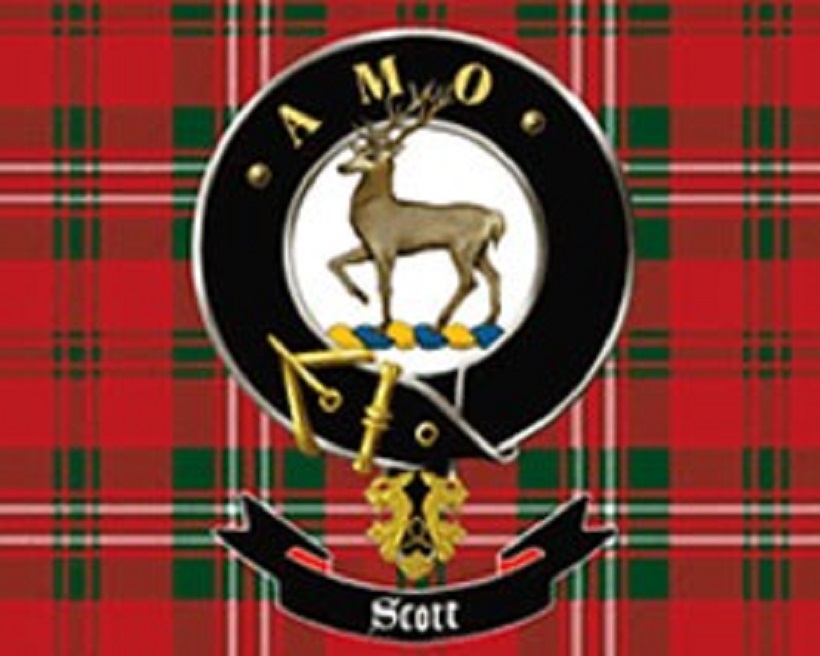
Above is a combination of the Clan Scott heraldry and tartan. Though I begin the tale of
my Scott line with this image, the truth is that such symbols were adopted long after my
line came to America. It's something to identify with, but they're symbols actually invented
by very distant cousins in Scotland. Before I got into genealogy, I wasn't even sure that
our Scotts came from Scotland. It would seem obvious, given the name, but my dad said we're
Irish. Actually, what he said was we're Irish, Black Dutch, and Cherokee. And my mom said
the same of her side. It turns out that the history of both sides of my family followed a
considerably similar path, but this tri-part description has proven to not be particularly
useful. I'll save my mom's side for the McAtee documents, but here let's begin by tackling
how my dad came to carry that tradition to me, or at least my attempt to make sense of it.
All I had known previously about the Scotts, beyond my dad and uncles and grandfather, was
they came from Montgomery County Arkansas, and that side of my family had a history in
Tennessee. That history also comes from his mom's side, which I'll save for the Howell
document and others. If you continue with me on this journey, you'll learn the deep Tennessee
history of the Scotts, which I doubt that my dad was even aware of. Tennessee became a state
in 1796, and we Scotts had been there four decades earlier, in an area that was then loosely
part of North Carolina and Virginia.
Let's first address the Irish part of our Scotts. Until I learned the truth, I envisioned
my line coming from poor potato farmers who immigrated during the Great Famine in Ireland.
That shows how little consideration I gave it then, given that none of my relatives were Catholic.
I asked a Scottish friend, and he said you could only get the name Scott from a Scot. But when I
searched online, I found claims that the name was from both Scotland and Ireland. What I've
learned is that all Scotts in Ireland have their roots in Scotland, even if they've forgotten.
I'll tell the entire story of our line going backward in time, and you'll see that they indeed
immigrated to America from Ireland, but their deep roots were in Scotland, specifically in Clan
Scott territory in the region of the border with England. One name for this migratory pattern is
Ulster Scots. They're also called Scots-Irish, or Scotch-Irish in America. Northern Ireland is
separate from the rest of Ireland today because of all the Scots who moved there, beginning in
the 17th century.
Considering the entire scope of Irish-ness on my dad's side, which I will cover in this and
other documents, I'm pretty sure the Irish part comes specifically from the Scott line. As
the tradition came to me that we're Irish and not Scottish, it suggests that we enthusiastically
changed when we left Scotland, and ceased considering ourselves to be Scottish. That may be,
but I have another theory. You'll learn in this document that our line first settled in
Pennsylvania when it came to America. This was probably the most common place for Presbyterian
Scots to immigrate, as well as Lutheran Germans. From my experience, most of the Scots in
Pennsylvania came directly from Scotland rather than via Ireland. It's my understanding that the
term Scotch-Irish was a relatively late invention, after our Scotts had left the eastern seaboard.
I believe that when our Scotts arrived, they called themselves simply Irish to distinguish
themselves from the Scots directly from Scotland. There were little to no Catholic Irish in
Pennsylvania at that time, so this simplification caused no confusion there, nor when the Scotch-
Irish as a whole began migrating through the Appalachias into the south. So, my theory is that
they continued to call themselves Irish, and themselves may have forgotten their Scottish origin.
I didn't know about it until I educated myself on my deep family history that wasn't passed down
to me.
So, now let's look at what Black Dutch means. My dad didn't know, and I didn't. I had the
opportunity to visit Holland about the year 2000 and asked several people there. They'd never
heard of it. I asked German friends if Black Dutch was related to the Black Forest of Germany,
as in Black Deutsch. They'd never heard of it either. I learned by research that it turns out
Black Dutch was a term made up in the early history of America for people of not-entirely
European ancestry who could pass for "white". Most commonly this mixing was with people of
African descent, which began when they were enslaved in this country. Mixing with Native
Americans was also part of the Black Dutch tradition. I've found that I have Native American
ancestors throughout my family tree, but they're too deep in the past to register in my DNA
ethnicity report. I don't know if the Black Dutch tradition on either side of my family came
from a particular source, but I do know the most obvious candidate on my dad's side. That story
is in the Howell document.
Though I know that I have Native American ancestry on both sides of my family, it's mostly on my
mom's side. And I've learned that not only my parents and Elizabeth Warren claim to have
Cherokee ancestors. The tradition of having a "full-blood" Cherokee great-grandmother is as
American as apple pie in the south. It's largely not baseless either, at least considering
Native American tribes generally. The reason why everyone claims Cherokee is because of that
people having a better reputation amongst white settlers than others. Back in the day, if one
couldn't or wouldn't deny that they had "Indian" ancestry, they would claim it was Cherokee to
have more pride in it. That said, I do have evidently valid claims of specifically-Cherokee
ancestors in the Meredith tree, which you can learn about in that document. The Cherokee do
play a significant role in the history of our Scotts, so stay tuned.
So, in summary of this introduction of the development of my own understanding of what my Scott
side came from, the Irish, Black Dutch, and Cherokee description isn't very useful. It is
understandable how it came to be, but I'm definitely not very Black Dutch or Cherokee - 1% at the
most. I've got some Irish, particularly closer to the Scott line, but I doubt that much influence
from them came down to me. I will specifically lay out my ethnicity, through my great-great-great-
great-great-great grandparents, the Scott eighth of which will be told at the end of this document.
Grover Thurman Scott 1888-1961
The first phase of this journey will be told with respect to the individual men of our Scott
line, going back as far as I have names for them, which is generations before the Revolution.
Though we probably never will know the names of earlier men, there is still quite a story to tell
of earlier times. The second phase will take our line back through the Irish Plantations and
Scotland, all the way to before the development of human civilization, which is possible due to
what my Y-chromosome reveals. If you don't believe it, just stay with me. We have quite an
adventure to go on. The final phase will cover the rest of the family tree of Frank Scott,
my great-great-grandfather, through all of his great-great-grandparents. Keep in mind that most
of them lived their lives before the Revolution.
Grover Scott was my great-grandfather, born in the South Fork township of Montgomery County
Arkansas. South Fork is no longer marked on maps, but it was just south of Mount Ida. I suppose
all the townships there got merged into Mount Ida itself, which was first established as a post
office in 1842, the same year the county was formed. Artifacts are still found in Montgomery
County of ancient Native Americans that lived there. Hernando de Soto was in the area in 1541,
and he was injured in a battle with the Tula tribe at modern Caddo Gap. An apparently sparse
native population was in Montgomery County in 1812 when the first white American settlers came.
But the natives didn't remain, and I've heard of no particular event that drove them out by the
time our Scotts arrived. Montgomery County is as rural now as is was in Grover's time, located
to the west of Hot Springs and Lake Ouachita. The lake wasn't formed until 1953.
Grover was born during the presidential campaign of 1888, which was won by republican Benjamin
Harrison. His opponent was Grover Cleveland, who was running for re-election. Cleveland's running
mate was Allen Thurman. By the name Grover Thurman, it's clear whose candidate was preferred by
the Scotts. Of course the south was solidly democratic at the time. Cleveland would run again in
1892 and won a second term. I haven't delved much into the politics of that time, but I think it's
worth noting that Harrison won the presidency in 1888 by the electoral college, because Cleveland
got 0.8% more of the popular vote. The late 1800s were called the Gilded Age, as the country was
rapidly industrializing and its titans were accumulating vast wealth and using monopolistic tactics.
While factory jobs greatly increased wages, such that European immigrants flooded in for them, it
was also a time of extreme inequality. For our Scotts, and I think every single line in my tree at
the time, they didn't live anywhere near an industrial center and continued in a very rural
existence, growing their own food for the most part. This was also the aftermath of the Civil War
and the collapse of Reconstruction, a difficult period in the south, which to this day remains
largely economically depressed compared to the rest of the country. If most of my ancestors didn't
yet envy factory work and city life, they did have to deal with bushwhackers and the environment
that produced the KKK.
Possibly our Scotts went to see Cleveland when he passed through the northeastern part of the
state in late 1887 on a goodwill train tour, on the way to Memphis from Kansas City. He
was warmly received in the south, even though he was a "damn yankee" from New York. The
republican party wasn't popular in the South at that time. Aside from opinions on
emancipation, it's doubtless that Arkansans hoped for better fortune with the democrats,
something that party has also largely failed to achieve to this day, at least in the South.

Mr and Mrs Cleveland's reception in Memphis, as illustrated in Harpers Weekly
The most notable event of Grover's life isn't part of my line. His first wife was Doshie Anderson,
and they had two living children by 1916. The first was born in 1912, and the second born in 1914
didn't survive. Doshie passed away in 1918 at the age of 30, I presume in her fourth pregnancy.
It must've been devastating for Grover. Doshie's tombstone is in good shape, still resting in
Owley cemetery just down the road from South Fork. Grover's second wife is my ancestor, who was a
Meredith. Grover's mother was also a Meredith. I suppose it was a bit of an emergency that
prompted this marriage of kin, with Grover having two young children to support. See the Meredith
document for more on their two lines.
Grover registered for World War I that same year, and requested (understandably) an exemption to care
for his family. Grover's older brother William moved to Lee County around that time, near the
Mississippi River, and Grover and family followed him. That's where my grandfather was born, and set
him on the path to marry into the Howells of Mississippi. Lee isn't far from Memphis Tennessee,
which they would gravitate toward. In 1940, Grover's occupation in Lee County was lumberman. My
grandfather eventually moved back to the Montgomery County area and settled in Hot Springs, where he worked at
the Reynolds aluminum factory. He might've returned to Mount Ida, but the Great
Depression had a huge impact on the county and what industry had come, such as lumber, didn't remain.
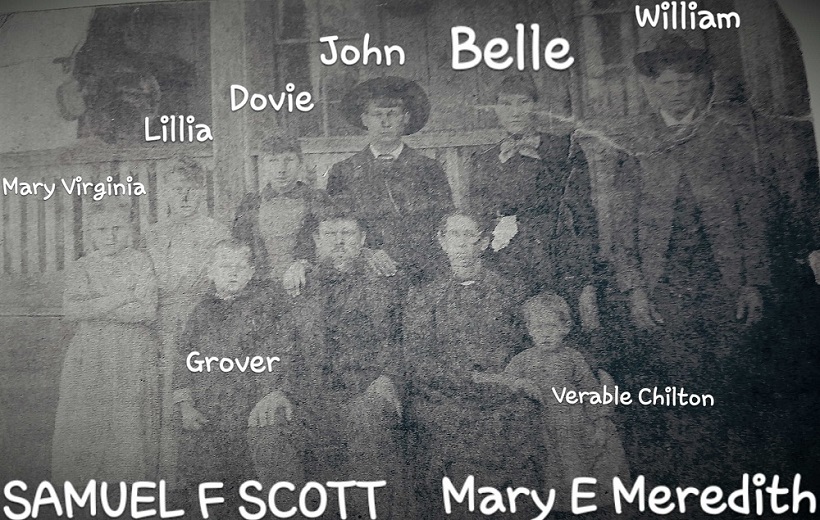
Seven-year-old Grover and family, photo annotated by Barbara Eubank of the Warnekes and Belle Scott
Samuel Franklin "Frank" Scott 1852-1925
Grover's father was Frank Scott. Frank's first name was Samuel, which is suggestive of early relations
of the family, which I will get to. It's interesting that he went by his middle name, because the family
had a connection to the name Franklin. I'll cover this subject later in the document also, because it
was relevant more than 60 years before his birth. Note for now that it was tangentially related
to Benjamin Franklin.

Frank Scott, probably in his early 40s
Frank's prominence in the family is evidenced by Scott cemetery, which is the only reference I'm
aware of for the location of the old South Fork township. Frank has a large tombstone, integrated
into an enclosure of several stones, though his brother William's is the largest in the cemetery.
"Preacher Bill" seems to have been a somewhat infamous figure. More on him later. Owley Road, or
route 2237, runs east from highway 27 south of Mount Ida and passes Owley cemetery, where Grover's
first wife Doshie was buried. Scott cemetery lies about halfway there, south of the road amidst the
woods. This is private property, I don't know who owns it now, but we were given a tour on a recent
visit by a Warneke relative. If not for his mowing of the grounds, the cemetery would be swallowed by
the trees. I presume the remnant of the old Scott homesteads might be found nearby if one was willing
to brave the ticks, or maybe they've been replaced by the buildings that currently stand.
Frank was the first of the line born in Arkansas. July 1852 seems solidly to be his birth date, and he
always claimed that he was born in Arkansas. An important datapoint on the time of the move was the
family was in the 1850 census of Marshall County Tennessee. Another is that Frank's sister Susannah
wed in Marshall in 1851, and she moved to Montgomery. The next are that Frank's sisters Elizabeth
and Matilda wed in Montgomery in 1853. So, the move fell within a year of his birth. I don't know
how common it was for pregnant women to travel back then, which was an ordeal already, so I would
guess that if she was pregnant, it wasn't obvious at the point they set out. Somewhere from spring
to fall would seem the time to go, and I would guess that they departed in 1851 before Frank was
conceived.
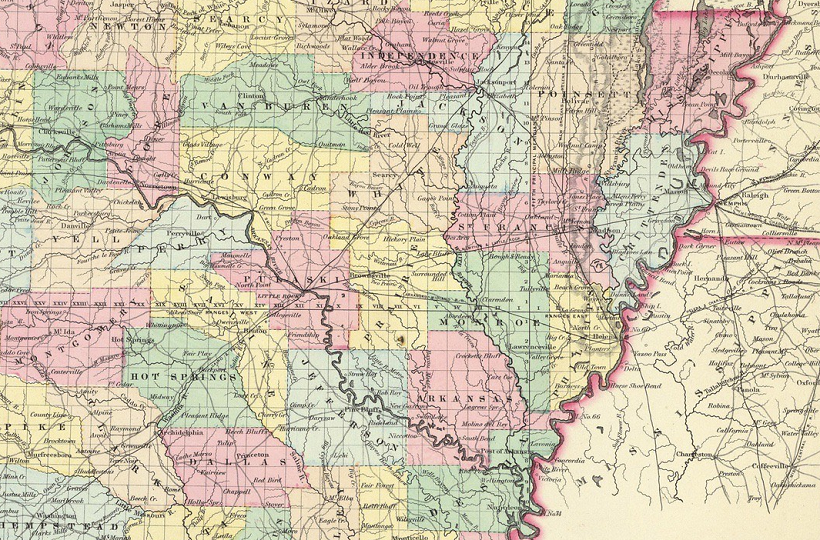
1856 map of Arkansas
When I began research on Frank, others placed his birth in Desha County. I've analyzed this in the
past, that it didn't make sense, being so out of the way. I considered that my line didn't
necessarily set out for Montgomery County. Maybe they were in Desha first, even if it was out of
the way. The answer to this question came in a newspaper article, a scan of which is pictured later
in this document. The family crossed the Mississippi River by ferry at Memphis, and went directly
to Montgomery by road from there. They never went to Desha.

Memphis circa 1850
Frank was 10 years old at the onset of the Civil War, so he wasn't a combatant, and his father
was 57. Frank's oldest brother Wilson enlisted in 1961 with company F of the Montgomery Hunters.
Duncan Meredith, another ancestor of ours, enlisted in the same company. That company fought in
battles throughout the southeast, beginning at Pea Ridge, and I'm not aware that either of them was
discharged early. Both men did survive. See the Meredith document for more on this subject.
Arkansas was readmitted to the Union in 1868, and a modicum of order was finally achieved by
1872, about the time that Frank started his own family.
It's amazing to me just how familiar Frank's face is. He looks to me like a combination of myself
and my brother. It was quite the experience when I first saw the scan of this photo in the Mount Ida
Heritage Museum. Much thanks to whomever it was that filed it. I have old family photos that passed
down to me, especially when word got out that I was working on genealogy, but they're all from my
mom's side. I haven't seen the original of Frank's obituary, but it's been preserved by the Merediths
in an email. The story is that, at age 73 and with a bad cold, in the middle of December, Frank went
out to plow his field and suffered a stroke, and soon passed. Obviously our Frank was a hard worker,
if capable of bad judgement.
William T Scott 1805-1873
Frank's father was William Scott. More is solidly known about William when he was an adult, because
the history of our line has been fuzzy while his father lived. William's own birth was apparently
fuzzy to him, because in the two censuses where he put his birth place, in one he put North Carolina
and in the other he put Virginia. In fact, I actually believe that he was born in Tennessee. I
will get to my reasoning in the next section on William's father, but for now it should be noted that
Tennessee became a state ten years before William was born. Also, the location of the family was
around the conjunction of Virginia, North Carolina, and Tennessee. There are good reasons why the
state they considered themselves to be in was fluid, which I will present in the next section.
The first document I'm aware of that solidy places William somewhere was in 1816, in Franklin County
Tennessee. This was a tax list, and the crucial information in it is that his mother Catherine was
head of household and her children were listed as 'heirs'. William's father had already passed, and
William was 11 years old. They wouldn't stay long in Franklin. It was apparently on a westward
thoroughfare of the time, because Davy Crockett is said to have also lived there briefly in 1812. I
mentioned above that Frank Scott's name was tangentially related to Benjamin Franklin. Franklin
County Tennessee was named after Benjamin Franklin. But this actually isn't yet our connection to
the name, I don't think. I will get to that, but not just yet.
William's history becomes clearer after 1816, with the family in the Lincoln County Tennessee census
from 1820 to 1840, where he raised most of his own family. Lincoln had been formed in 1809, on land
acquired from the Cherokee and Chickasaw in 1806. William's mother was a charter member of the Mount
Olive Baptist church there. Lincoln is on the Alabama border, close to Muscle Shoals. William's
brother Samuel was buried in Hester cemetery northeast of Petersburg. They lived in Lincoln in
Wells Hollow. The township is no longer on the map, but there is a Wells Hollow road. William was
in Marshall County in 1850, just to the north of Lincoln, where he had moved by 1847, when a child of
his was born there, while the previous were born in Lincoln.
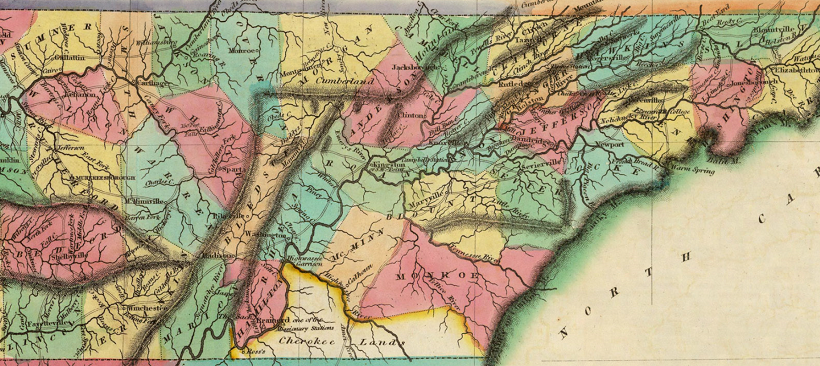
East Tennessee in 1822 (Lincoln County in bottom-left corner, Franklin adjacent to east)
When I began research on the Scotts, William's father's death was placed in 1819. I believe the
reason for this is that a Jane Scott who lived with Catherine in 1850 was born in 1819, and she's
been assumed to be a daughter of Catherine. I haven't solved this mystery, but I know for certain
that if she was born in 1819, she wasn't William's full-sister. This is proven by the 1816 tax
list, at the least. Jane might've been a daughter-in-law of Catherine and was widowed. She had a
different father from William, either way. The rest of William's story has already been told, as
he moved to Arkansas probably in the summer or fall of 1851. Also of note amongst the siblings of
my line, William's oldest brother was named Wilson Scott, he named his first son Wilson, and Frank
named his second son John Wilson. The importance of the name Wilson amongst our Scotts will become
evident as we move backward.
It's clear from my research that our Scotts were well-acquainted with Joseph Greer. He was called
the Messenger of Kings Mountain, because he delivered the news of the victory over the British
there to Congress during the Revolution. William's uncle was named John Wilson Scott, the first
of that name that I know of in the family. It's likely that John Wilson's father (our William's
grandfather) had been acquainted with Joseph Greer's father before the Revolution. I don't think
I've searched for Joseph Greer in the 1816 Franklin County tax list, but I wouldn't be surprised if
Catherine travelled with his group. Joseph became a prominent citizen of Lincoln County. Catherine
never remarried after the death of William's father.
Before we move on to William's oft-mentioned father and finally give him a name, take a look at the
newspaper clipping below about our Scotts in Montgomery County Arkansas. It was published in 1951
in the Montgomery County News. The writer of the article was evidently called Uncle Lige, whom I
don't believe is a relative, but an elderly resident of Mount Ida at that time who contributed
articles to the local paper. I'm also not sure if the whimsy of the tale is his creation or Scott
lore, but it's pretty funny either way. Note that the John Scott mentioned was William's older
brother, which is clarified in the latter part of the story. Take note of the info on Preacher Bill,
William's son. The Warnekes are mentioned because the most famous resident of Mount Ida was Lon
Warneke, who was a major league pitcher for both the Cubs AND Cardinals, and later was an accomplished
judge. He was a grandson of Frank, son of Belle Scott-Warneke. Lon has a huge tombstone in the
Owley cemetery.
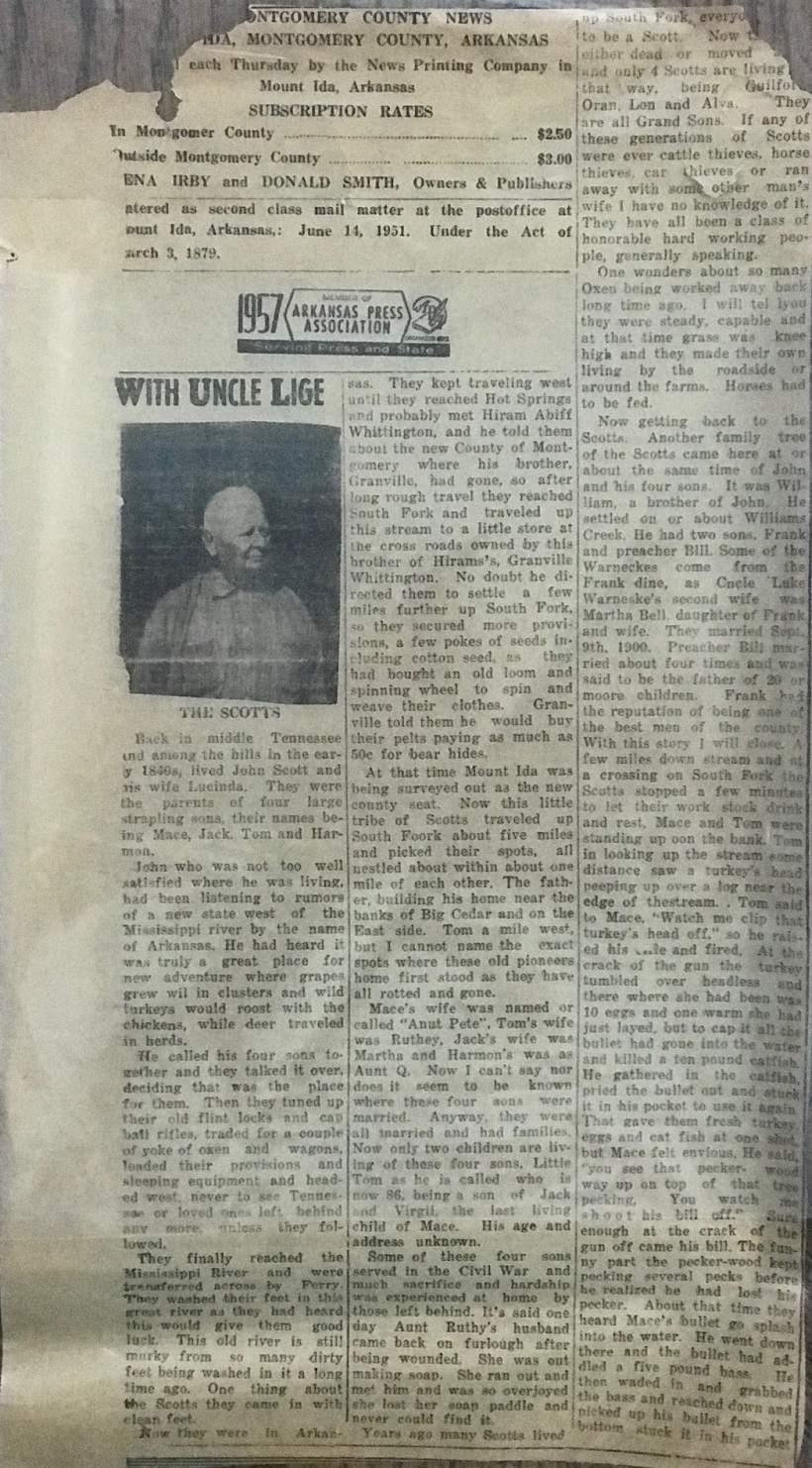
Andrew Scott 1773-1814
William's father was Andrew Scott. It appears that before I began research, no one was certain
who William's father was at all, as he died before 1820 and the family had lived up until that
time in places where no censuses were taken. They had very much been a frontier clan going back
before the Revolution. But by the time I did begin research, Andrew had correctly been identified as
William's father. This relied solely on Andrew and wife Catherine being listed in the probate
document for Andrew's father. When I got involved, nothing beyond that was known, other than
Andrew's being deceased before 1820. Andrew's father had lived in Washington County Virginia, where
Andrew most likely was born. Technically it was Fincastle County in 1773, as Washington County was
formed from Fincastle in 1776.
The first information to parse for Andrew is a marriage hint returned by ancestry.com for Catherine.
It has a Caty Hartsell wedding a John Scott in 1812 in Cabarrus County North Carolina. Remember
that Andrew's son William in our line was born in 1805. I know from DNA that Catherine Hartsell of
Lincoln Tennessee is my ancestor. If it weren't for what seems to me the unlikeliness that another
Caty Hartsell wed a Scott man, I would dismiss this record. And in the past, I did. But surely
this does apply to Andrew and Catherine. The least problematic element is the location, even given
that the info I have on the Hartsells is as spotty as that for the Scotts from the 1770s to the
1810s. Catherine's father was Jacob Hartsell, and her younger brother was also named Jacob. Jacob
Jr was born in 1780 in Burke County North Carolina, which isn't far from Cabarrus. As far as I
know, Jacob Sr wed in Burke, so Catherine would've been born there too. So, it's not crazy to
think that Andrew could've wed Caty in Cabarrus. I have other German ancestors from Cabarrus, so
maybe that was a desirable place for Lutherans to wed. That could explain why Caty's husband was
named John in the marriage document, as many German men in my tree had a first name of John, for
their patron saint. They may have done this for all grooms of German brides, even if they weren't
named John. The thing I can't explain at all is the year 1812. I'm absolutely certain that Andrew
and Caty weren't in North Carolina at all in 1812, and I doubt they would've traveled there.
Certainly not Caty. I know they were in Tennessee in 1812, which I will explain later, and my
guess is they raised their family there. Maybe they were unable to wed formally and retroactively
got a license. That's the best I've got to explan this.
As far as I know, I'm the first to connect any dots between Andrew's listing in his father's
probate and his widow's being head of household in Lincoln Tennessee in 1820. The first step in
this process was finding the aforementioned 1816 tax list in Franklin Tennessee. From that we
know Andrew had already passed by 1816. The next piece of information is that I searched for
Andrew in War of 1812 registrations. I found several, but I think one clearly is ours.
According to the published memoirs of Jacob Hartsell, who was Caty's brother, they both moved to
Washington County Tennessee as children in 1790. Records of this may be found in the Deed Book
in the Jonesborough county courthouse. Jacob's memoirs were about his experience as a
captain in Lillard's 2nd regiment in the War of 1812. An Andrew Scott also registered in Lillard's
as a sergeant, from Washington County. I'm certain this was our Andrew. He met Caty there and
they raised their family there.
Mary McCown, who edited Jacob's memoirs and did genealogical research on the Hartsells, found that
the land acquisition in 1790 was at the Brushy Fork of Cherokee Creek. I haven't found Brushy
Fork, but Cherokee Creek runs through the west side of the modern community of Lamar. In the area
is a Hartsell Road and Scott Hills Road. I'm sure that neither are a coincidence. Andrew and
Caty lived there, just south of Jonesborough. Remember that Tennessee didn't become a state until
1796, and our Scotts had been there four decades before even that. Andrew was born about 30 miles
to the north, in the Virginia portion of the Holston River. See the map below of the Holston,
Watauga, and Nollichucky settlements. Cherokee Creek is just to the east of Limestone Creek
printed on the map, technically in what had been the Nollichucky settlement when Andrew was born.
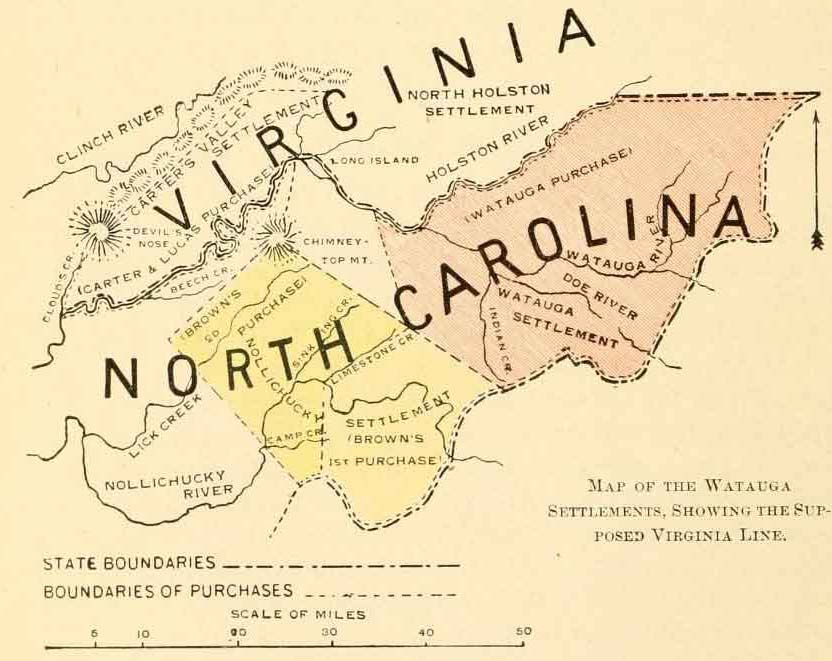
At that time, the British didn't recognize these settlements as being legitimate, due to an
agreement with the French in 1763 that barred British settlement on the west side of the Appalachian
chain. The entirety of what would become Tennessee was called the Washington District of North
Carolina until 1777, when it officially became Washington County. By 1812 Washington County been
whittled down by the formation of other counties, and remained centered around the town of
Jonesborough. Andrew's father died in 1803, and Andrew returned to Washington County Virginia to
settle that business, but he still lived in Washington County Tennessee.
So, we know that Andrew died between 1812 and 1816. I've found no direct proof of what happened to
him. We know for certain that Andrew was part of Lillard's regiment. Lillard's regiment was
divided into groups of men led by the captains. Lillard was a captain of one group, and Jacob
Hartsell was a captain of another. In Jacob's memoirs he listed his sergeants by name. Andrew was
a sergeant and he wasn't mentioned in Jacob's memoirs, which means that Andrew wasn't in Jacob's
company. I've seen a list of Jacob's company, and Andrew wasn't there. I haven't found Andrew in
any list of any company of Lillard's regiment. But I don't think I've found lists for all of them.
And we know he registered for it. Lillard's was active in the latter months of 1813.
The War of 1812 was a broad conflict between the United States and Great Britain. The US attempted
to conquer Canada. The Star Spangled Banner was composed. The British burned the White House.
One of the key elements in the South was that Britain and Spain didn't recognize the 1803 Louisiana
Purchase as valid. In 1812, Florida belonged to Spain. In 1815, the British launched an attack on
New Orleans, even though the War had technically already been concluded by then. The British and
Spanish recruited the Creek nation to declare war against the United States, as American settlement
had been accelerating in Creek territory, which consisted of much of the modern states of Georgia
and Alabama. The Creeks are otherwise known as the Muskogee.
Most Creeks didn't want war, but a faction called the Red Sticks did. They desired to keep Americans
out of their territory, and to stop other Creeks from assimilating with them. What prompted action
in Tennessee was the massacre perpetrated by the Red Sticks at Fort Mims in the summer of 1813, where
the mixed community of Americans and Creeks there were slaughtered. This resulted in the quick
formation of militias to defeat the Red Sticks, in what is called the Creek War. Tennessee is called
the Volunteer State, and the University of Tennessee's mascot is the Volunteers, because of the
volunteer militias that were raised. The first militias formed were in October in central Tennessee,
called West Tennessee at the time, under Andrew Jackson, and in eastern Tennessee under John Cocke.
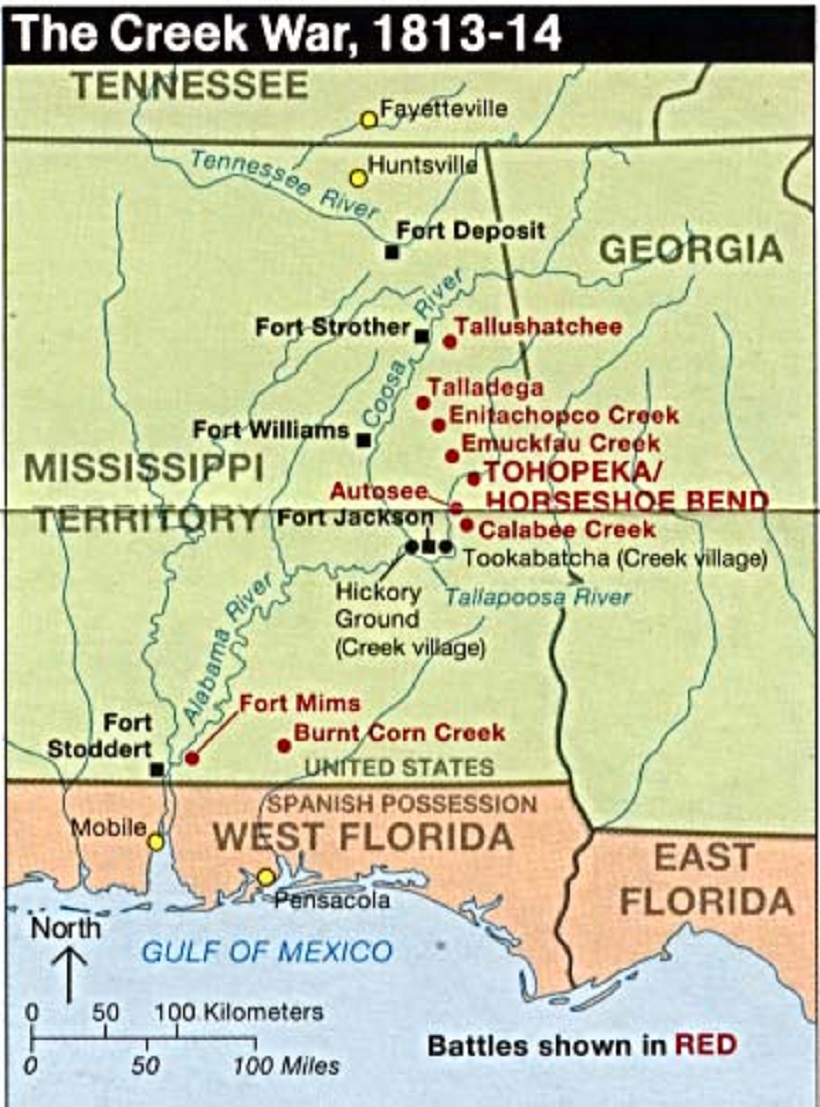
Lillard's regiment participated in no major battle and returned home in the middle of January 1814
when their enlistments were completed. Jacob Hartsell's memoirs confirm this, as he returned home on
February 4th. General Jackson continued from mid-January with some men from Lillard's who remained,
into the battles of Emuckfaw Creek, Enotchopo Creek, and the culmination at Horseshoe Bend, where the
Red Sticks were conclusively defeated. Jackson went on to capture Pensacola and later led Tennesssee
volunteers to the Battle of New Orleans. I've presumed that Andrew was killed under Jackson's
service, but though I've reviewed casualty lists, I've not found his name. On top of this, his widow
Catherine never applied for a military pension or any kind of recognition other than listing her
children as Andrew's 'heirs'. The best I can guess is that he died in some kind of accident
peripheral to official service. But I can't see how it couldn't have been related, given the timing.
John Scott 1734-1803
Andrew's father was John Scott. The only documentary evidence we have for John is when he was an
adult. His eldest son was named John Wilson Scott, as has been mentioned. John Wilson was
significant in the family because our knowledge of John Scott's origin and his father relies
completely on John Wilson's pension application testimony, where he
declared he was born in York County Pennsylvania, and he stated his grandfather's name and that he
immigrated from Ireland about 1725. This, to the best of my knowledge, is the only proof we have
that our line was Scots-Irish. We have other proof that they were Presbyterian, which I will get
to, which shows that they were originally from Scotland.
My research into Scottish history in Pennsylvania leads me to believe that our line settled in
what's called the Barrens in what was eastern York County in 1763 when John Wilson was born. I'll
dig deeper into this in the next section. The Barrens are on the west side of the Susquehanna
River near the Maryland border. My best guess is that both John Wilson and his father John Scott
were born there, either at Peach Bottom or a neighboring township. York County was formed from
Lancaster County in 1749, taking the land west of the river. Therefore the Barrens were in
Lancaster County when John Scott was born. Findagrave.com has John Scott's birth in Philadelphia,
which wasn't terribly far away. This is possible, but I doubt it, and I'm sure the Scotts lived
west of the Susquehanna. The name Barrens speaks for itself as the least-desirable land in the
area. Germans had moved in decades before and taken the better parcels. As I said, I'll get back
to this subject.
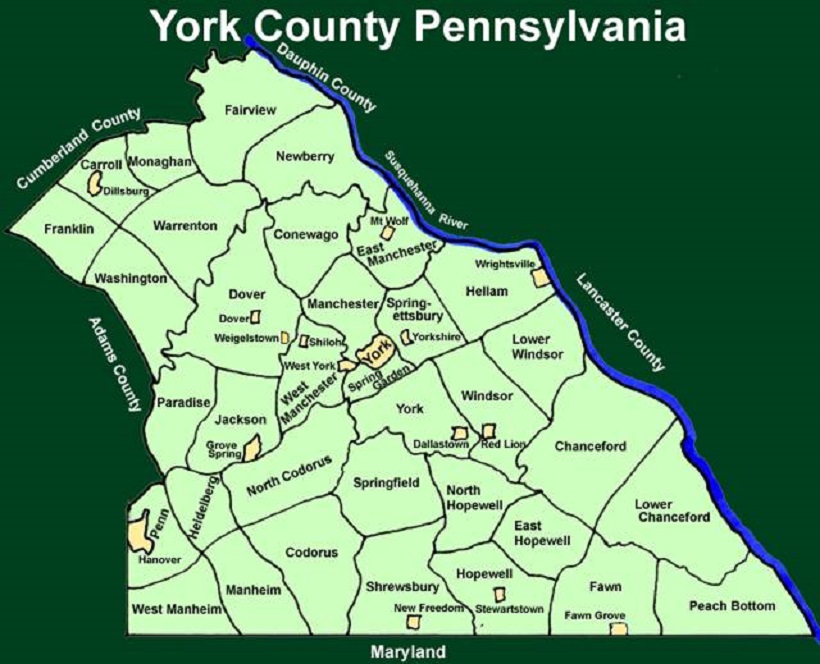
John's story gets interesting when the French and Indian (F&I) War began in 1753 when he was 19
years old. The War is named from the British perspective, against the French and their Native
allies. Battles occurred in western Pennsylvania, particularly at modern Pittsburgh, and
Scots-Irish men like ours were involved. But our John wasn't, not yet. York County was raided in
1755 by the Shawnee, and women and children were ferried across the Susquehannah to take shelter.
Battles with Native tribes extended down into the Holston area of future Tennessee. But during
the F&I War, settlement was very sparse on the Holston. Wooden stockade forts here and there were
the primary presence of Americans.
One fort that evidently was key in our story was established on the north side of the Holston
River opposite of what's called the Long Island in the river, which ended up being in Tennessee
when state boundaries in that area were finalized. According to documents at the Washington
County Historical Society library in Abingdon Virginia that I've not personally verified, John
"Trader Scott" during the F&I War set up a trading post on the Watauga River a few miles east of
the Long Island fort, and his uncle operated a post at modern Blacksburg Virginia, setting up a
supply line that must've been essential for people in the fort. This was years before the Watauga
Settlement was established, very much the wild edge of the frontier.
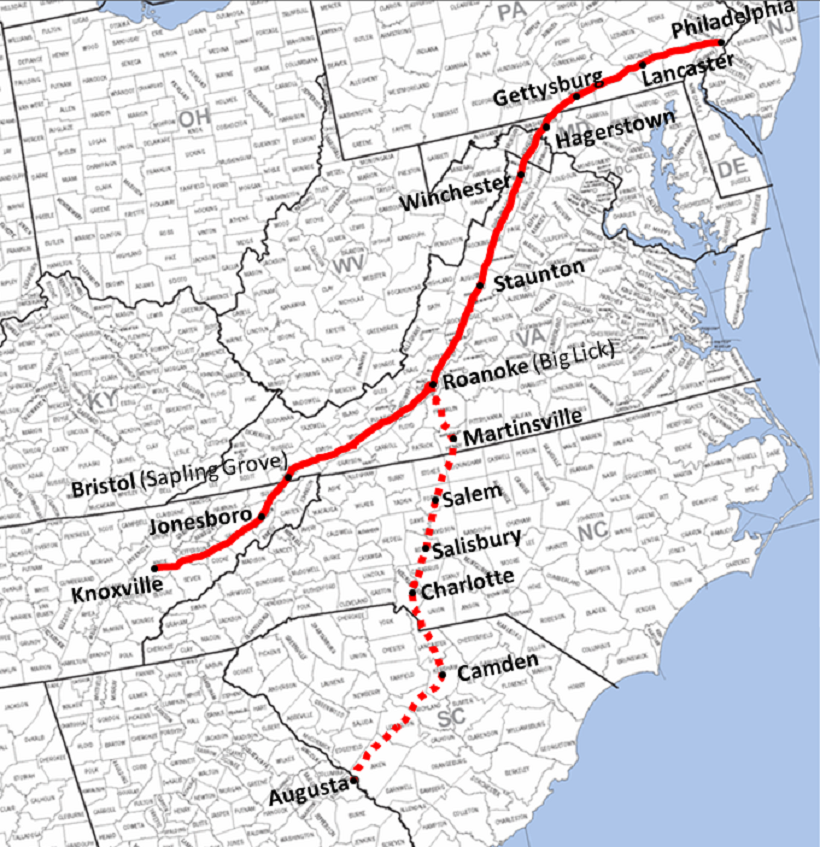
The Great Valley Road, AKA The Wagon Road, AKA The Wilderness Road, AKA The Warriors' Path
The above map is very significant to our Scotts' destiny. In fact the majority of our ancestors
used the Wagon Road in a general movement from Virginia to the Carolinas and points farther south
and west. John Scott and his uncle (who was also named John) traveled from Pennsylvania down it
during the F&I War, and set up their supply line along it, delivering needed goods to the fort at
Long Island. I've read that a village of traders and hunters formed at Fort Loudoun, a better-
known fort farther south from the Long Island and at the same time, and we can use it as a
reference for what our John experienced. I don't know what became of the fort at Long Island,
but Fort Loudoun and its village were abandoned after a siege by the Cherokee.
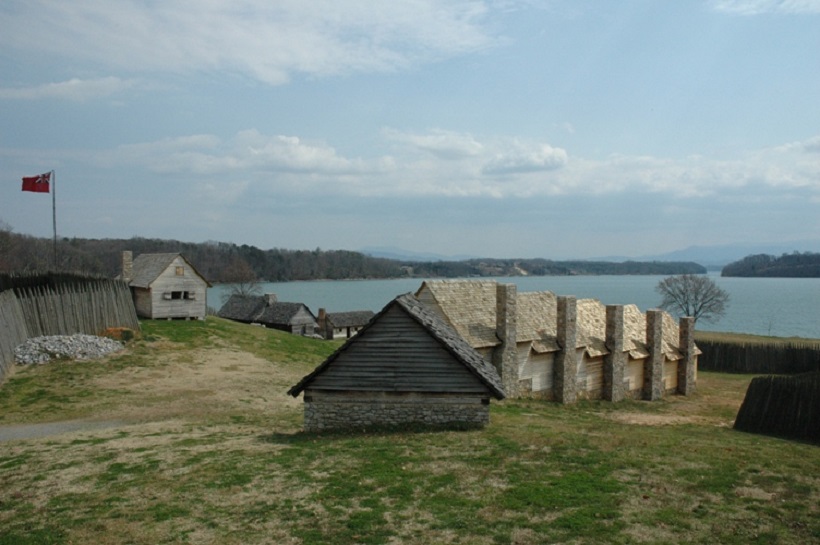
Reconstruction of Fort Loudoun on-site
The Chickamauga part of the F&I War ended in 1761 with a treaty signed on the Long Island itself.
Chickamauga is the name the local Americans called the Cherokee. The Island was a sacred place
to the Cherokee, and they maintained possession of it until 1806, long after they ceded all the
surrounding lands. Sadly, to say the least, today the Island is mostly covered by a chemical
processing plant. For additional context, Daniel Boone is known to have been around Watauga in
1760, and it's quite likely that John Scott met him then. This was 15 years before Boone began
clearing the Wilderness Road into Kentucky, starting from the Long Island. But getting back to
our tale, after the War ended in 1761, John Scott returned to the Barrens and John Wilson Scott
was born there in 1763.
In 1771, on the north side of the Middle Fork of the Holston River, on the site called Ebbing
Spring, in what was Botetourt County Virginia at that time, a Presbyterian Meeting House was
built for the growing Scots-Irish population there. A petition was sent in June to the eastern
part of the state for Charles Cummings to become their minister, which he accepted. Also in
1771, a treaty was signed where the Tribes sold the land of future Washington County to Virginia.
In 1772, our John returned with his family down the Wagon Road to this same site and planted an
acre of corn. The rule at the time was that such an improvement entitled a man to 400 acres of
land. I believe this was the first legitimate land acquisition by our Scotts in America, as I
suspect they simply squatted in the Barrens, which was common at the time for immigrating Scots
and Scots-Irish. It wasn't until 1781 that the Ebbing Spring property was actually surveyed,
and formally granted in 1783. Probably at that same time, the Ebbing Spring Meeting House (by
law they weren't allowed to call it a church back then, boo Virginia!) was accounted as attached
to John's property, and he later received a grant for it. And getting back to 1772, technically
Ebbing Spring was in Fincastle County, which was formed from Botetourt the same year. The
property was in Washington County after 1776, when it was formed from Fincastle.
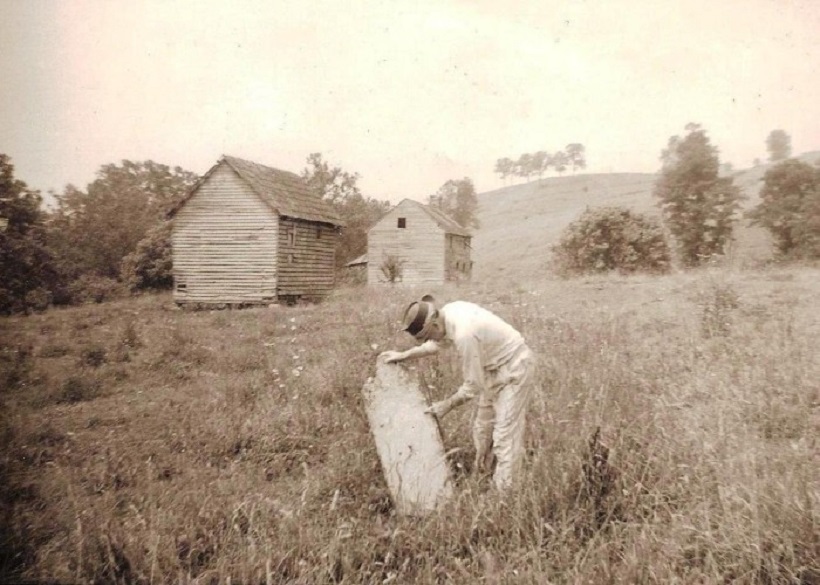
From
ramblingroots.com, 1965 photo of old Ebbing Spring cemetery - the buildings captured
weren't our Scotts' but were built at the same time they were there
Meantime in 1772, the Watauga Association was formed, a settlement in the area where John had
earlier earned the moniker Trader Scott. Andrew Greer, father of Joseph Greer of Lincoln County
Tennessee, was an Indian Trader in Watauga. I don't doubt that John Scott was acquainted with
their family before the latter relationship previously mentioned. The settlers attempted to get
around the ban on settlement on that side of the mountains by leasing the land from the Cherokee,
but the British (and the colony of North Carolina) still didn't approve of it. Even though the
area of Washington County north of the Holston had been purchased and was supported by Virginia,
the Shawnee didn't respect the invasion of their hunting ground, and they frequently attacked.
Minister Cummings was said to keep his shotgun ready in the corner of the room when he preached
to the congregation at Ebbing Spring.
The Holston area was in the hunting ground of the Cherokee from the south as well. The Shawnee
came there from as far away as Canada. The settlers had generally peaceful relations with the
Cherokee, at least until the British formally allied with them during the Revolutionary War.
The Scots-Irish settlers in Holston and Watauga, who were called the Over-mountain Men, emulated
some of the tactics of the Natives, including carrying scalping knives. As for the Shawnee,
they were always in a state of guerilla warfare with the settlers. 1776 on the Holston was a
time of frequent invasions, kidnappings, scalpings and murder, with women and children sheltering
in forts until the danger passed. Skirmishes between the Cherokee and American settlers from
1776 to 1794 are called the Chickamauga Wars.
John Wilson Scott's other significance to the family was that he fought in the Battle of Kings
Mountain in the Revolutionary War in 1780, at the age of 17. Colonel Ferguson of the Redcoats
was tasked by General Cornwallis to drive the settlers out of the Holston area, and he warned
them that he would raze their settlements to the ground. In response the Over-mountain Men
took the initiative and marched out to meet Ferguson in the field. They caught up to his forces
at Kings Mountain, which is in South Carolina near the North Carolina border, where they
defeated him totally and imprisoned the survivors. Kings Mountain played an important role in
Cornwallis's eventual surrender to Washington at Yorktown.
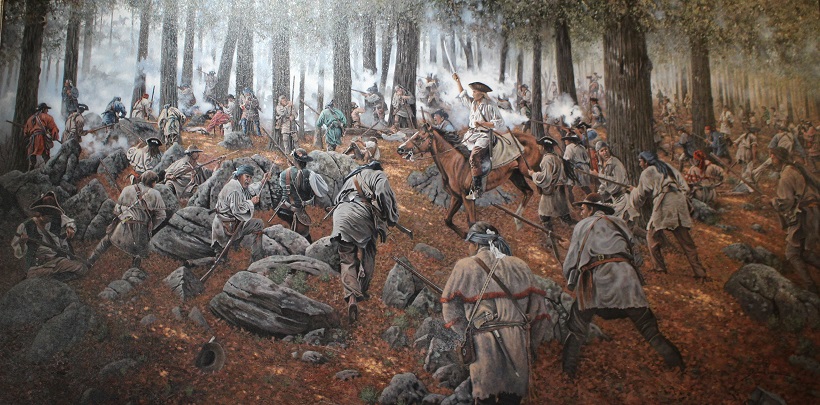
Depiction of Over-mountain Men at Battle of Kings Mountain
As stated, our Scotts were fiercely anti-Crown, not to ever be mistaken for a Tory. The
latter were as much a danger to the Over-mountain Men as the Cherokee, joining Ferguson's and
Cornwallis's forces. In fact, our Scotts were part of the short-lived State of Franklin, in
desire of self-rule. Arthur Campbell of Washington County, a leader of the militia and no
doubt friend of the Scotts, was an early proponent. He called it at first Frankland, which
would've been entirely independent of Britain, and he envisioned it including Kentucky and
Tennessee and southwestern Virginia. But his vision fell out of favor, largely because
Patrick Henry, the governor of Virginia, had interest in Kentucky becoming its own state. The
bounds of the state of Frankland were then limited to eastern Tennessee, and the name
changed to Franklin in an attempt to recruit the support of Benjamin Franklin. This is what I
believe was the tribute made in our line, how my great-great-grandfather was called Frank, to
the attempted free state of Franklin. It operated from 1784 until 1796, though it wasn't
recognized by the federal government, then it folded and became part of Tennessee. While the
state of Franklin lasted, its capitol was Jonesborough, where our line later
lived, and from where Andrew volunteered for the War of 1812. I'm certain that Andrew was
acquainted with Joseph Greer in the Jonesborough area, as the latter's family was still there.
And note that Andrew Jackson practiced law at Jonesborough for a time.
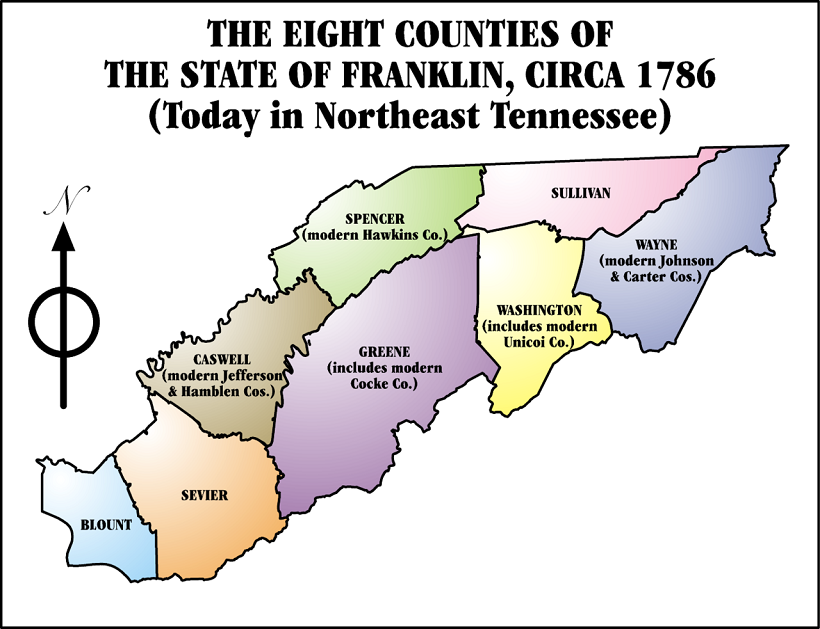
Washington County Virginia maintained a militia during the years our Scotts were there. The
only one of the family I know to ever have served in it was John Wilson, when he fought at Kings
Mountain. Several John Scotts served throughout Virginia in the Revolutionary War, but I'm
certain that our John Sr wasn't one of them. I see him being one of the primary men defending
the Holston area settlements against Shawnee attack. A John Scott served
under Alex Mears in Montgomery County in 1782, according to the book Virginia Soldiers of 1776
in the Richmond state library, but I don't think this was our John.
John Wilson, returned from Kings Mountain, maybe was in a position to guard the family while Sr
supposedly went on this trek, but I would sooner believe that John Wilson went. I don't think
it was either. Sr would've been 48 years old in 1782.
John Sr appeared in Washington County tax lists, which I haven't personally accessed, from 1781
to 1802. He died in 1803 without a will, but a probate record remains where his sons left land
to their mother, who cared for a sister who was called "an idiot". It's from this document
that we know for a certainty of our descendancy from John (aside from DNA evidence), because it
names Catherine's husband as Andrew, and Catherine was our William's mother. I haven't
personally validated any document that claims this, but it's said that John was called Captain
John Scott. Descendants of the Kincannons who wed into the John Wilson Scott line referenced
him as such. Putting the information together that I have, I believe he got the title not from
Revolutionary War service, but in the Anglo-Cherokee War 1758-1761 at the Long Island fort, and
the title paid respect to that service throughout his years in the Holston area. Note that
John was cremated upon his death, which is curious. It might indicate an affinity with the
Cherokee and their reverence for the Long Island, which played such a fundamental role in his
own life.
Patriarch Andrew Scott and Relatives
John's father was Andrew, according to John Wilson Scott's military pension testimony. In
locating where I think John Scott was born, other researchers have attempted to apply
Pennsylvania land documents to Andrew, but I don't think any are a fit. Really all we have is
a general picture of John's father. We know he was Presbyterian, because John himself was
Presbyterian. The line became Baptist under Catherine's guidance in Lincoln Tennessee, and she
had been Lutheran. We know Andrew came from Ireland, so being Presbyterian meant that he was
Scots-Irish. We know that he immigrated somewhere around 1725.
One evident fact that has grown in my mind is that Andrew had only one son in America. There
were other contemporarty Scotts in Pennsylvania and the Holston area, but there's no evidence
that any of them were siblings of John. It could be that Andrew had daughters, but if he did
I'm not aware that any descendants of them have traced to him. Given how many children people
tended to have in the 18th century, and in our line subsequently, I'm sure what this means is
that Andrew was not a young man when he came to America. Some researchers have selected a
1706 birth in Scotland for him, and some have experimented with a Samuel being his father.
None of this leads anywhere, and the births are too close together, and I certainly believe
that Andrew was born long before 1706 anyway. I'll come back to that as we cross the Atlantic
to investigate our history on the other side.
To learn more about Andrew, we can reference other Scotts in America at that time. Genealogy
is informed by three sources of information: one is direct documentation. Another is to use
place and time context, what I would call indirect documentation, to make solid conclusions
that are almost as good as direct documents such as birth, marriage, death, census, land, and
tax records. And lastly genetics has arisen as a third source, especially as the direct
documentary trail runs out, as it does with our immigrant Andrew Scott.
DNA will become my primary source of information as we continue backward in time, especially
Y-DNA, the Y-chromosome, as I carry it in me from Andrew and his forebears. We have a solid
documentary trail from me to him, and we know there were no adoptions or other disruptions
between, largely due to male descendants of John Wilson Scott having the same Y-DNA as me.
Before we get to the specifics on DNA, just know for now that ours is unusual for Scotts. We
know of one contemporary Scott of Andrew's who had the same Y-DNA as us. Others in the same
area may have been related to him through wives, but this one had a common male ancestor.
His name was John Scott. He was known to have been Scots-Irish, and he immigrated to
Pennsylvania in 1745. He took his family down the Wagon Road in 1762 to North Carolina. He
had sons named William, John, and Samuel, like our line. He lost an arm in an Irish
rebellion, and yet was known for his penmanship, which means he was literate. A birth of
1706 in Scotland is attributed to him as it is among many for our Andrew. I haven't done
much work on one-armed John, but if he was Scots-Irish like our line, his line wouldn't
be all in Scotland as researchers of him seem to think. I have heard that Scots in Ulster
would go to Scotland to get married or have their children baptized, but they would've
returned to Ulster.
Given the rarity of our Y-DNA and similarity in path with one-armed John, I'm sure that Andrew
was closely related to him. If you recall in the story of our John Scott, he operated a supply
chain from the Long Island with his uncle John who was up the Wagon Road in Virginia. I think
it's possible that one-armed John was that uncle. If I'm right that immigrant Andrew was
probably born in the 1680s and died in the 1750s, one-armed John was a younger man than him.
He immigrated 20 years later, and I think he was likely 20 years younger. This works against
him being our John's uncle, but doesn't preclude it. In the end, all we can draw from one-
armed John having a common male ancestor with Andrew, is support for the Ulster-Scot origin
and that Andrew was probably also literate. I do know that education was valued amongst the
Presbyterian Covenanters, as our Scotts were.
The other Scotts that I believe are informative for our line came from a Hugh Scott that a book
was written about. His descendants have been tested to be the usual Y-DNA of Scotland, so they
weren't related to Andrew by a common male ancestor. Hugh's line is known to have lived at
Peach Bottom in the Barrens in Pennsylvania. I think it's quite likely that Andrew knew them,
maybe they were related through wives of Scotts, and that he went to the Barrens because of
them. A Samuel Scott who was descended from Hugh also lived in Washington County Virginia, in
Cedarville which is very close to Ebbing Spring. The two lines very well may have travelled
down the Wagon Road together in the early 1770s.
So, let's analyze Andrew's immigration. I believe that he was an older man when he arrived in
1725, so he probably had a family in Ireland. I tend not to believe that he was a scoundrel
and abandoned them to come to America, although there was a David Scott of the same Y-DNA as us
who went to Connecticut, and that was indeed his story. His former wife sued him and won. As
for Andrew, there happens to be information that supports him coming to America against his
will. I've learned that it wasn't only Australia that took in masses of convicts from Britain.
So many were banished to America that Pennsylvania blocked more ships carrying them, and they
went instead to Maryland. Jacobites and Covenanters like our Scotts were often arrested for
simply existing, as they were a threat to the Crown, and they were banished to 'transport' to
the colonies.
An Andrew Scott is documented being imprisoned in Newgate Gaol in London and delivered to
Baltimore in 1730, who could've been ours. Scots-Irish like Andrew were used essentially as
frontier mercenaries in the colonies. This served as a form of indenturement, potentially
explaining how Andrew could've arrived in 1730 as a prisoner and had a family in Pennsylvania
by 1734. Remember that the Barrens are very close to the Maryland border. Unfortunately, at
the time of Andrew's arrival, there was no requirement for ship manifests to be recorded, so
if he arrived by some other way, there's probably no record of it. If he did come directly
to Pennsylvania, ships carrying Scotch-Irish landed at Philadelphia, and many at Newcastle
Delaware to avoid paying the Pennsylvania landing tax.
These seem to be the two possible ways that Andrew came to Pennsylvania, but now let's stay in
Ireland and consider our Scott history there. I've attempted to research all the conflicts
that went on in Britain during the American colonial period, because they impact all of my
ancestors. But it's frankly bewildering, trying to keep track of who was on whose side at
which time. They frequently switched alliances, for any number of reasons. As I've said
before, our Scotts were against monarchy and supported the parliament in the English Civil War.
They were also Presbyterian Covenanters who desired for their form of Protestantism to be the
state religion of Great Britain. What I want to know about our Scott line is to understand why
and when they went to Ireland. The first important fact to consider is that a plantation was
established at Derry in 1609. Derry had previously been a Catholic monastic site, but when the
English established a plantation there, they built a walled city and named it Londonderry.
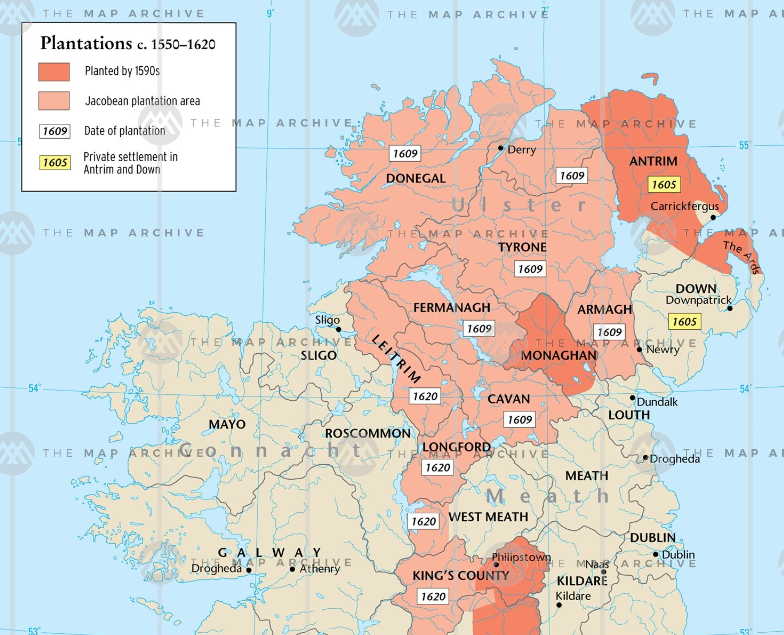
Irish Plantations by 1620
The native Catholic Irish were dispossessed by the establishment of plantations, and every
uprising by them resulted in worse punishment. Troubles over religion led to the Wars of the
Three Kingdoms starting in 1639, leading also to a Scottish Civil War in 1644. A Catholic
rebellion in Derry in 1641 failed in its attack on Londonderry. In 1642 General Munro landed
in Derry from Scotland with a force of 10,000 to protect the Covenanters in Londonderry. The
army was disbanded in 1644, but many chose to remain. Considering the military background of
our Scott line, I think it quite possible that this is how and when they entered Ireland.
Considering that they chose to live a rural life in America until the entire country was
industrialized, it would seem unlikely that they lived in a city in Ireland either. There was
a Jacobite attack on Londonderry in 1689, in what's called the Williamite war. This failed,
so I'm not entirey sure what impact that had on my Scotts or even what side they were on. I
don't know if it was possible to live a rural existence, if their role was to defend Londonderry.
They may have had to shelter within the walls, maybe a lot of the time.
Their occupation was merceneries, and had probably been so in Scotland too. They were hired to
fight against Catholics or Royalists, or whomever they were aligned against at a particular time.
That included the overthrowing of the English monarchy in 1649, and they could've been involved in
the taking of Londonderry for the Parliamentarians in 1650. The monarchy was restored in 1660,
and life seems like it was consistently bad for Covenanters for a long time after. 1679
to 1688 was called the Killing Times, where they were hunted and executed. Many Scots came to
Ireland in the 1690s due to a famine in Scotland. I'm certain that our Scotts were in Ireland
by then. Catholic rebellions happened in 1715 and 1745, the period in which Andrew immigrated.
There were also harvest failures in that time, and extreme rent inflation. If Andrew was on the
prisoner ship to Maryland, he probably was apprehended during a rebellion. As I've stated, I
tend to believe that he didn't come by choice.
Clan Scott and our Y-Chromosome
The surname Scott is said to have come ultimately from the Romans, who named all Celtic people
outside the British territory they controlled Scotti. From what I've read it wasn't a Latin
word, but came from the Celts themselves. It's been considered to have equivalent meaning as
'Irishman', which of course is ironic considering that I used to be confused over whether we were
Scottish or Irish. If you look far enough backward in time, the distinction between Scot and
Irish disappears, as there was much movement between the two lands and most Scots could trace
their origins ultimately to Ireland. But not our line. I'll explain soon.
The progenitor of Clan Scott is believed to be a man who named himself Uchtred Filius Scot in a
document in 1118. A lot can be determined from the name. First, Filius Scot meant "son of a
Scot". Second, Uchtred was an English name. That actually makes sense, and I'll eventually get
to the point of explaining why. From Uchtred descended the Scotts of Buccleuch, the power center
of the Clan. Like anybody, the top goal I had in researching my Scott line was to determine how
we connect into the Clan Scott hierarchy. I hoped to find a path to the Hardens, to be related
to the infamous border reiver Auld Wat, and the author Sir Walter Scott. Hugh Scott of Peach
Bottom whom I mentioned before has been claimed to descend from Harden, and I think it's probably
true. Their DNA doesn't disprove it, at least. See the map below for the location of Clan Scott
territory.
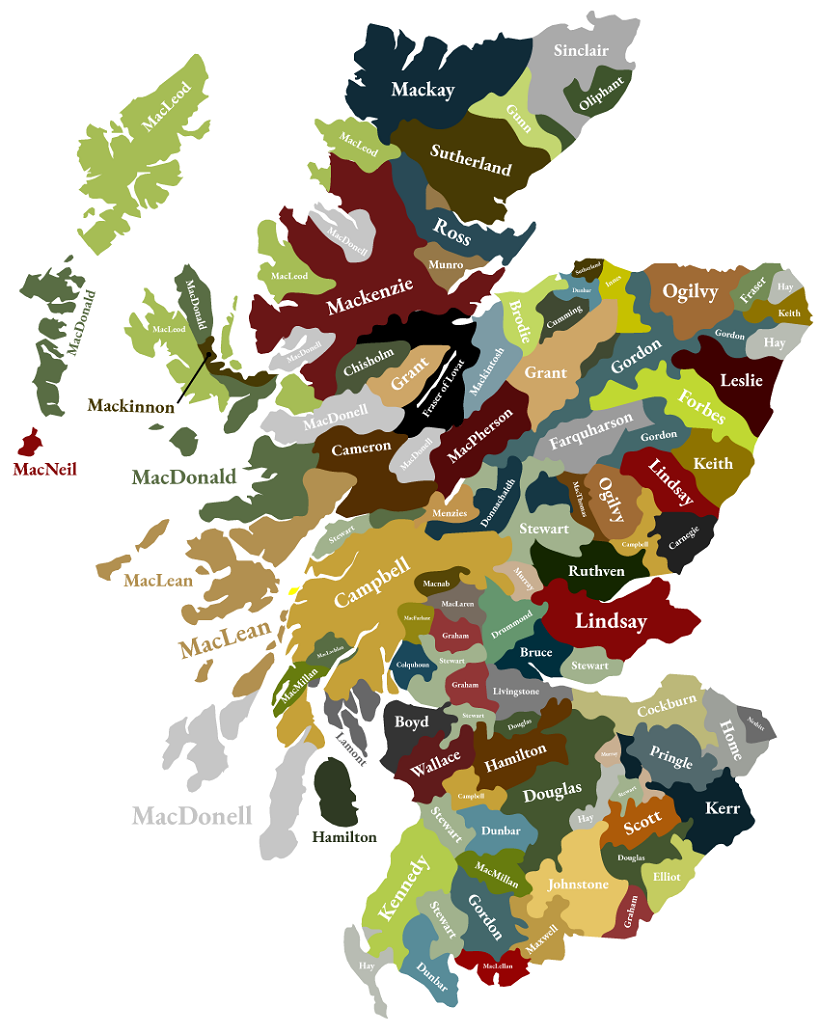
I've done a lot of work collecting info on all Scotts I could find in Ireland when Andrew
immigrated and earlier, but nothing has led to a clear connection to our line, let alone from
Ireland to Scotland. So, all I'm left with to go by is my Y-DNA. The Y-chromosome is passed
from a man to his sons, on and on forever. The hypothetical Y-DNA Adam is named that because
all people on Earth today descend from him, so Y-DNA can be traced all the way through history
back to him. I've had mine tested, and descendants of John Wilson Scott have been tested, and
descendants of one-armed John Scott of North Carolina, and the result is haplogroup J-M172,
also called simply J2.
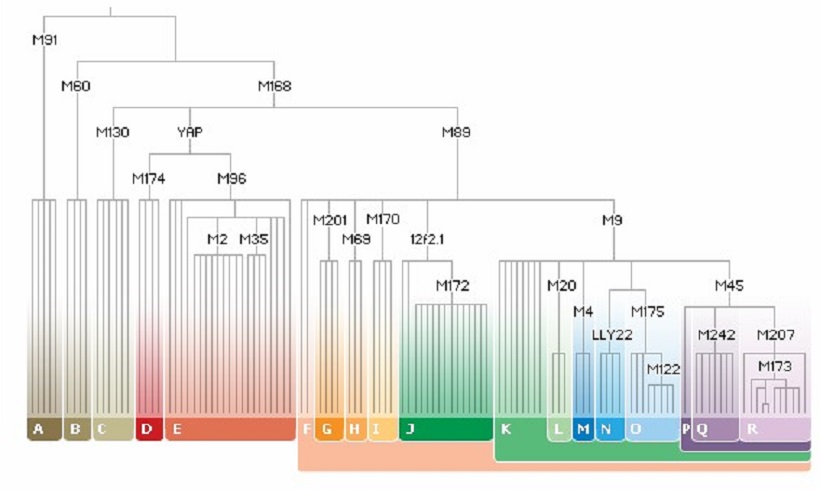
Y-DNA Tree, showing the descent of each major haplogroup
I'm specifically J-M67, branch S25258. What I'll say about J2 right now, is it turns out to be
very rare in Scotland. I saw an immediate benefit in this though, in that rarity narrows the
possibilities of where it came from. Surely I could find the precise branch off the Clan Scott
tree it came from. But no one I asked knew the answer. And it required an adoption somewhere,
because of course, otherwise all men descended from the progenitor would have the same Y-DNA.
I came to the conclusion that J2 doesn't connect to any Scott gentry at all. Buccleuch was
originally haplogroup R-M269, and Harden descended from it. Therefore we can't descend in male
line from them. Of all the Scottish surnames I've researched, R-M269 is the most common in the
majority, if not all of them.
But the fact is, most people with Scottish surnames didn't get them by being descendants of the
gentry - they adopted their name by allying with that Clan for mutual benefit. Scott territory
is the eastern lowlands of Scotland, in the region of the border with England. At the time our
Scotts left Scotland, it was a lawless dangerous place. Clan Scott were what are called
border reivers. A reiver was a raider, a horseman of age 16 to 60 who crossed the border to
steal English cattle, or of a rival Scottish clan. The English on their side of the border
were reivers as well. The term bereaved comes from having been raided in this way. Borderers
were encouraged to move to the Irish plantations in the 17th century as a way of attempting to
pacify the region.
We're part of Clan Scott, but not by father-to-son descent. You could say we're more genuinely
Scott than R-M269 men, because our line chose to be part of the clan rather than being born
into it. J2 exists in several clans, including Armstrong and Elliot and Montgomery, each less
than 5% of the total. All these J2 men probably joined those clans in the same manner. From
what I've seen, among Scots J2 is most concentrated in the same territory as Clan Scott, as
well as Armstrong and Elliot. I expect that when a family adopted a Clan surname, it was
because they already lived in that clan's territory from time immemorial.
I also expect that our Scotts were in the middle of the reiving and lived on farmsteads, not
peddling wares in Edinburgh. They were either called by a lord to aid in a reiving, or they were
called by kings or parliaments as soldiers in wars. The adoption of surnames didn't become
common until the 16th century, and I expect that was the case for our line. We've been in
America for 300 years, and we became Scotts only 200 years before that.
Leveraging Unique Y-DNA
We all probably want to find out that we descend from
some great king of old. But even if you have less ambitious goals and just want to learn the
truth of your origin no matter how humble, I've learned that you can't necessarily do that.
The research that produced this document began with the idea that if I search hard enough,
consult enough sources, I'll find that ship my ancestor came on, where it came from, and
connect it back to the family history on the other side of the Atlantic. But the fact I had
to come to grips with, is not everything was written down in the past. In actuality most events
were not documented, especially the further back you look in history. I had to come to the
conclusion that if my ancestors weren't gentry, weren't wealthy, weren't landed, they would
fade into obscurity. It's clear that my Scotts hit that fading point backward from 1725.
I've also mentioned the study of historical context to figure out the story of family lines.
I attempt for all my ancestors to understand the path they took, as far back as I can. Even
though the paper trail runs out at the point of immigration, and I won't ever know the names
of any individual men before Andrew who came to Pennsylvania, I know by the fact that John
Scott was a Presbyterian that the line came from Scotland. By our surname I know that we
came from the eastern lowlands. So, my father-to-son line definitely traces back to a fairly
small area in the 16th century.
This goes back farther than autosomal DNA evidence could. But the Y-chromosome, passed only
from fathers to sons, is a genetic record that can be traced to the very origins of
humankind. Even when mutations occur, they don't obfuscate where your line came from - they
help to distinguish them more accurately. The rarity of our Y-DNA in Scotland, shared by the
descendants of John Wilson Scott, and one-armed John Scott of North Carolina, provides a
unique insight into the deep history of Britain. As stated before, our Scott Y-DNA is of the
J2 haplogroup. Take a look below at a map of the concentration of J2 men today, from Britain
to India.
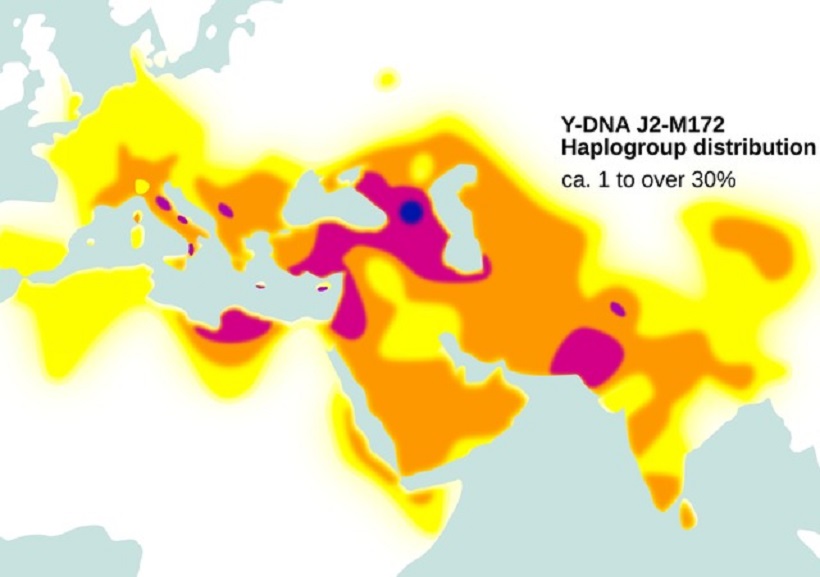
J2 is typically called a Middle-Eastern haplogroup, but based on this map I'd say it would be
more accurate to call it Caucasian. That darkest spot is evidently the origin point, north
of the modern country of Armenia and just south of the Caucasus mountains. J2 is believed to
have split from J1 about 28,000 years ago. This is seriously deep history, when all humans
were hunter-gatherers and Scotland was under a mile of ice. I expect at this point you
either think there's been some mistake, that this can't be the Y-DNA of someone from Scotland,
or you're wondering just how the heck it came to Scotland. How, indeed. Well, there is no
mistake. If I didn't have such solid information to trace my male line to Scotland in the
16th century, the best assumption would be that one of my forebears was a Middle-Eastern
foundling that somehow got adopted by an American family. You probably can find recent
immigrants to Scotland who came from Armenia and other J2 sources. But not in the 16th century.
You can tell that J2 does exist in Britain. By this map it doesn't reach Scotland at all,
but I think it's filtered to lose resolution at that far a distance. Still, this does
illustrate how rare it is in Britain. Other maps of J2 are out there that are somewhat
different, based on how the data was collected and processed, but this map certainly is useful
to draw basic conclusions. One, people don't move randomly, and obviously J2 men thrived over
the millenia more in some places and less in others. I believe that J1 is very common in what
had been Mesopotamia, but I don't know why J2 seems to have avoided it, relatively speaking.
There's an apparent affinity of J2 with other civilizations that developed, from the Harappan
to the Levant to Hittite to Greece to Rome. I believe this is related to the default
explanation for how J2 came to Scotland: through the spread of agriculture. The earliest
successes of agriculture led to J2 population booms.
So, lacking a better explanation, my Scott line came from men who migrated westward from
Armenia to Scotland, a long time ago. Agriculture was developed about 10,000 years ago, so it
seems that we can be sure they were somewhere in the Fertile Crescent until then, and then
moved west for a few thousand years until they reached Britain. These J2 men were in Britain
as time went on, from Stonehenge being built, to the Celtic tribes coming, to the Romans, to
the English, to the establishment of Scotland. I do believe that this was the story of the
majority of J2 men in Britain in the 16th century. But I do actually have a better
explanation for my line, something much more specific, and it applies to other border clans
as well. Several of them have J2 concentrations of around 5%, and some are even
higher. That might not sound convincing, but the typical J2 concentration in Scotland is
less than 1%.
People have become very mobile in the modern world. America has been called a melting pot of
different peoples. You might think this never happened in the deep past, especially in
Britain. You might see the people who live there as having been homogeneous until the last
century or so. But that's not actually true, not even close. I would say that the basic
driver of different peoples mixing has always been empire, that when an empire arises and
expands across the globe, it brings quite different people into contact, and results in some
exchange in both directions. The British empire did that, going to India and Hong Kong and
Africa, and eventually some of those peoples came to Britain and settled there. I bring this
up as an example, not to suggest that our line came from the Middle-East in modern times,
because we know it didn't. Our Scotts were firmly planted in Scotland before the British
empire arose.
The British certainly were not the first empire in the world. When I learned about my Y-DNA
being Middle-Eastern, I accepted the theory that my male forebears were part of the
agricultural revolution, and they helped bring it to Britain. It's a pretty cool thing to
know. But then I came across the work of a contemporary J2 of British ancestry, who has a
theory that it came to Britain with the Sarmatian Cavalry. That got my attention, and it's a
very entertaining idea because there's also a theory that King Arthur came from the Sarmatians.
The 2004 King Arthur movie is based on it. Now, look again at the J2 map above. The territory
of the Sarmatians was north of the Black Sea. If the ones who went to Britain came from the
northeast shore, the concentration of J2 there is very high. It certainly is an intriguing
idea that J2 men were stationed at Hadrian's Wall. That's not far from Clan Scott territory.
But this theory doesn't stand out as being more likely than a neolithic farmer source for J2
in Scotland.
That said, this did make me aware of something I hadn't known much about: the Roman empire in
Britain. I'm aware of no possibility of a Middle-Eastern man coming to Britain before the
16th century, except for the Romans, as their empire encompassed all of the Mediterranean,
including the Middle-East. The Sarmatian Cavalry was an auxiliary cohort that was stationed
at Hadrian's Wall. The Romans had attempted to incorporate all of the British isles into
their empire in the 1st century. This was before there was such as thing as England, when
Britain was populated by Celtic tribes, in the latter stages of the Roman empire, which
disintegrated in the 5th century and they withdrew toward Rome. When the Romans failed to
subdue what would much later become Scotland, what they called Caledonia at that time, they
built Hadrian's Wall to solidify the furthest extent of their control. They would later
construct the Antonine Wall further north when they attempted again to absorb the lowlands,
including future Clan Scott territory.
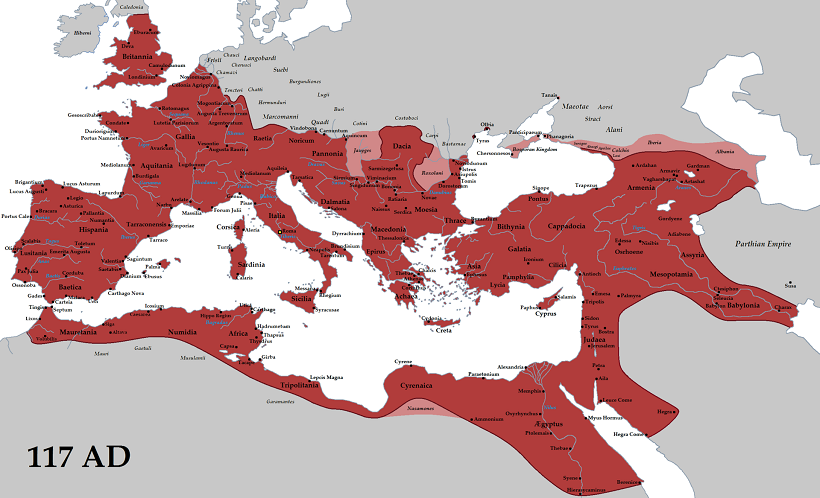
The Roman Empire
So, take a look at the map above, and remember the J2 concentration map. The Roman empire
incorporated a lot more potential J2 men than just the Sarmatians. There are several paths
whereby a J2 line in Britain could've been started by a Roman. Most of them are no more
compelling than the Sarmatians, such as bureaucrats from Rome itself. I don't believe that
many could trace to the Roman legions, although the second, sixth, and twentieth actually
built Hadrian's Wall. They weren't occupiers, and they moved on to campaigns elsewhere. It
was the auxiliary units that are more likely sources. As Rome added new nations to its
empire, it Romanized them by offering men and their children citizenship for 25 years of
military service. The auxiliaries came from the far reaches of the empire, and they were in
Britain for at least the term of their contract.

What a fort at the Wall looked like
There was a Moorish cohort from North Africa at the western end of the Wall. Read more about
them in the Hollis document on the McAtee side of my family. There was a Dacian cohort, from
the Balkans. These are possible for our Scott line, but still too random to have any
certainty. The more likely sources came from the far-eastern part of the empire. Believe it
or not, a cohort of boatmen came from modern day Iraq and were stationed at the eastern end
of Hadrian's Wall, at the fort called Arbeia. The J2 map above shows a relatively low
concentration in Mesopotamia, but it's still significant, and it brings in another factor
specific to the Scottish border region: kindred haplogroup J1. The majority of Iraqi men
today are J1. J2s are a fraction of the J1s, but they're the second most-common haplogroup
there. In my research I've observed more J1s than J2s in the Scott, Elliot, and Armstrong
clans. J1s aren't associated with the spread of agriculture, and they're even rarer in
Britain than J2s. I'm pretty sure that most every J1 man in Britain came from the Romans,
and the Iraqi boatmen would've been one of the primary sources. These boatmen would've had
a few J2s, and our Scotts could've descended from them. But such a theory still doesn't
carry enough weight to depend on for our J2 line. Yet there was another Roman auxiliary
cohort that had a much higher J2 concentration, and also a lot of J1s. And they were
stationed smack-dab on top of future Clan Scott territory.
Hamian Archers
To this point, neolithic farmers remain the most likely source of my Scott line in Britain. I've
brought up several potential J2 sources that came to Hadrian's Wall via the Roman empire, but
while any of them could have fathered sons while they were in Britain, none seem particularly
likely to be in our line. There is one more auxiliary cohort though, that I believe is very
likely to have started our line in Britain, so bear with me as I take a step back to tell
their story.
Syria became a Roman province a century before Britain was added to the Empire.
The Syrians were known for their prowess with the bow, and Syrian archers were employed in
Roman military campaigns in the Middle-East long before Julius Caesar set foot on British
soil. Five hundred such Syrian archers were sent to garrison Hadrian's Wall in the year 120.
They all came from the town of Hama, which was a little bit inland of Tripoli on the Roman
map above. I don't have exact numbers on the percentage of J1 and J2 today in Hama, but
based on the high concentration of J2 in the Levant, I would guess that of those 500 men,
about half were J1 and the other half were J2.
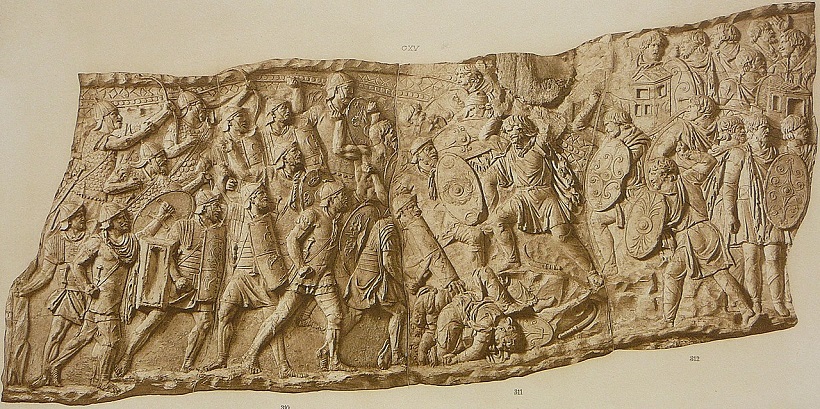
Syrian archers in conical helmets portrayed on Trajan's Column in Rome
120AD was a time of widespread construction of forts in Britain immediately preceding the
erection of Hadrian's Wall. The job of the Hamian archers was to help in pacifying the local
Brittonic tribes. They were stationed at a fort called Magnae, very near to the Wall, but as
it predated its construction, it didn't end up being incorporated like the imagined recreation
shown previously. A Roman Army Museum at Vindolanda today holds artifacts from Magnae. See
the maps below of the fort and a wider view of the intersection of Maiden Way and Stanegate
with respect to the Wall. The Hamians would've traveled along Stanegate (and Dere Street
(mislabeled Watling here) to go to the north).
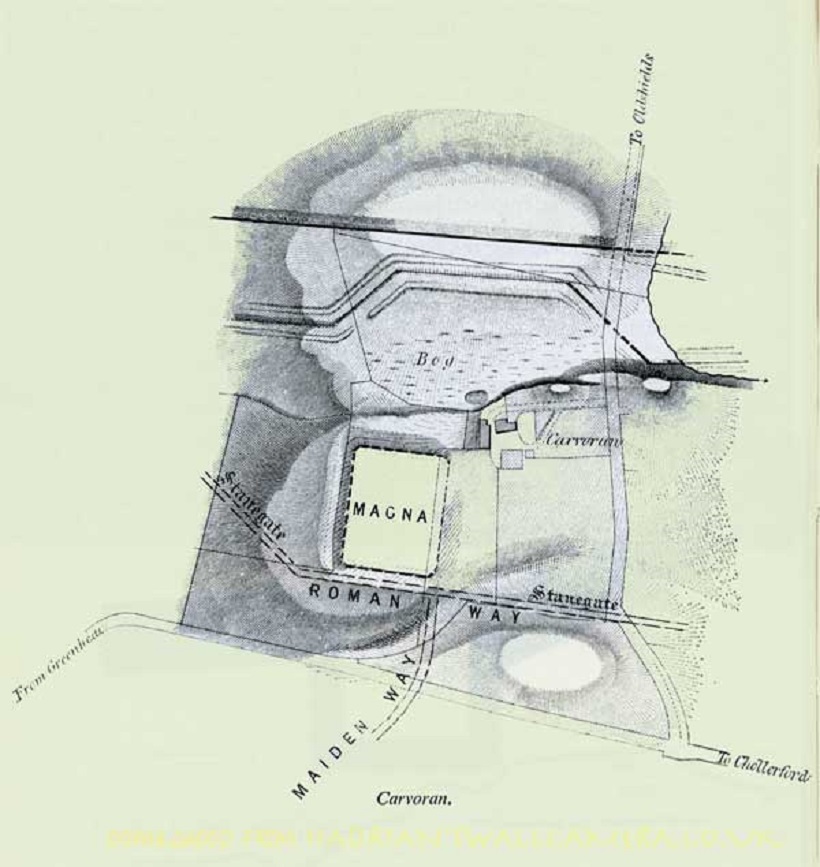
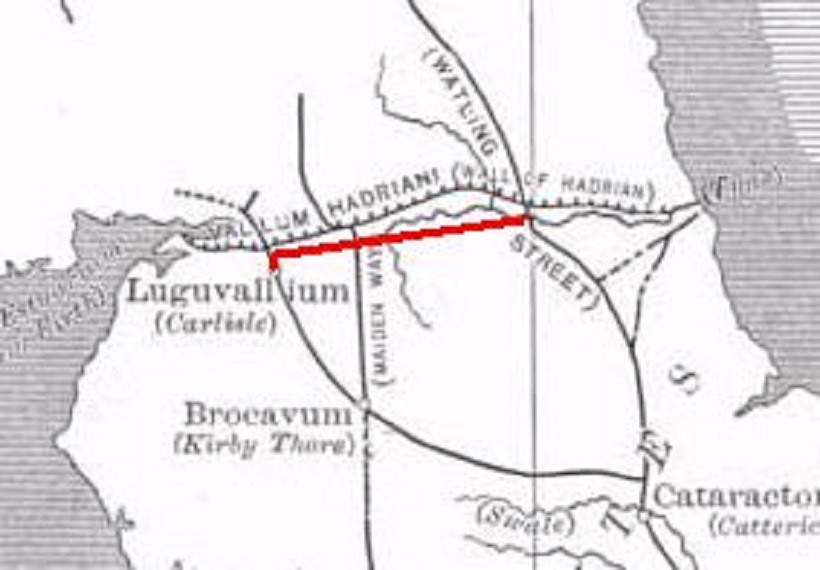
Some researchers have suggested that the Hamians were also employed to hunt game to feed the
legions and garrisons. It's interesting to think that our line may have shot bucks at the
ravine long before Buccleuch was named for it. The composite Hamian bows were suited to
shooting from horseback, and one unit of them was mounted. Considering that the reivers of
the last centuries while our Scotts were in Scotland were horsemasters, it makes sense that
our man was one of the mounted bowmen. It will make more sense as this tale progresses. The
military tradition in our Scott line is weaved throughout it, so it shouldn't be surprising
that it goes back to the Roman garrisons. I wonder if archery remained an occupational skill
in our line until the advent of firearms.
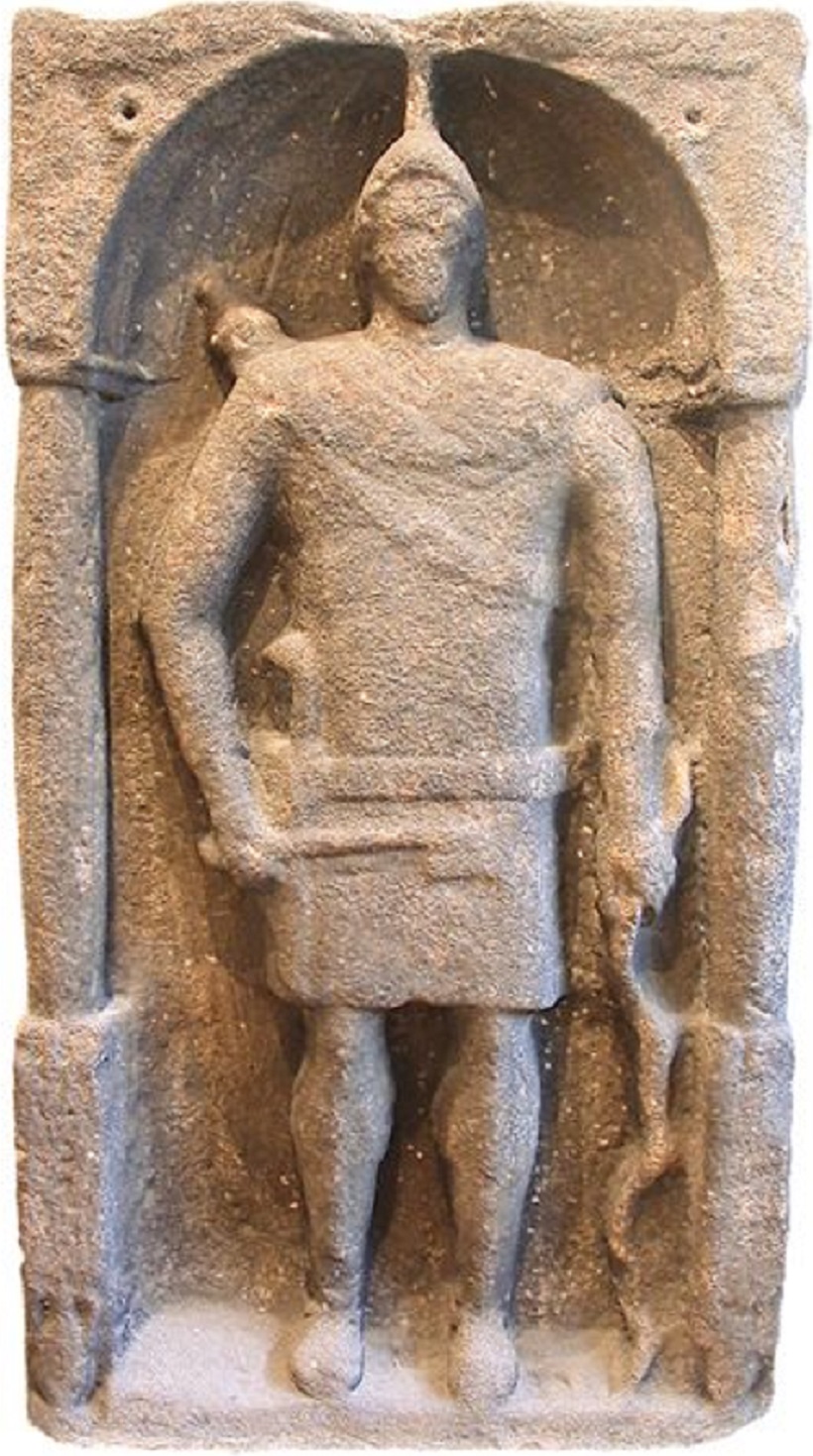
Tombstone of a Hamian archer in Britain, at Hancock Museum in Newcastle
Picture with me now the life of one of these Hamians. I expect that all were single men,
about 20 years old. They've signed on for 25 years of duty in Britain. By the end of their
contracts, they'll be 45 years old, old enough to be grandfathers. There was no ferry
service to take them back to Hama. They were British Romans now. Imagine what the winters
were like for them, having come from the balmy Mediterranean. I understand that George RR
Martin was inspired by this thought in his idea of the Night's Watch in Game of Thrones.
Roman soldiers weren't supposed to start families during this time. It wouldn't be until
the year 193 that Emporer Septimus Severus decreed that marriages were allowed, when
these original 500 were no longer living. Even if it wasn't legal for the 500 Hamians to
formally wed in their time, I'm
certain that none of them were celibate. Not even close. They might not have been able to
settle down with a local woman, as they slept each night in the fort, but I bet they were
able to at least keep track of sons they fathered. I expect that the 193 law was enacted
because there had been a great demand for it and they wanted approval of their lifestyle.

The citizenship diploma was a folding bronze tablet with service details
Information I've found about the Hamians says they were at Magnae until 142AD, upon which
time they were sent to the north. The aforementioned Dere Street passed right through
future Scott territory. In fact, the Romans built a large fort complex on this road near
modern Melrose in Scotland. In this area are the Eildon Hills, a fundamental part of Clan
Scott lore, upon which had been built a hill fort by the local Celtic tribe, the Selgovae,
occupied from 1000BC but abandoned before 142AD. The Roman fort was named Trimontium
after the nearby three peaks of Eildon. Trimontium had been initially constructed in 80AD,
and was abandoned and rebuilt and abandoned again with the ebb and flow of conflict between
the Romans and Brittonic tribes (primarily the Damnonii to the west), before the Hamian
archers were sent there.
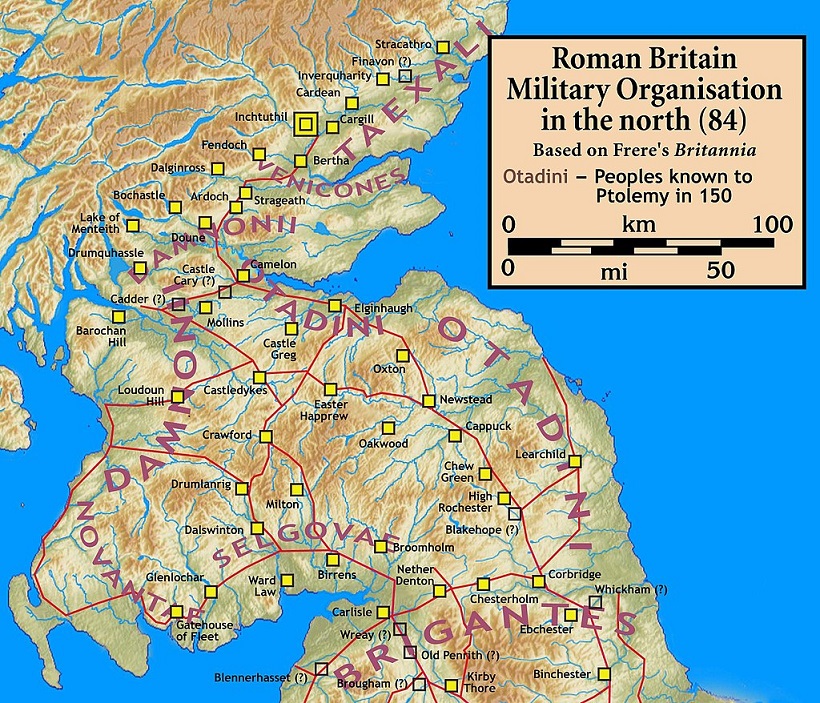
Take a look at the map above. The red lines are Roman roads, and the yellow boxes are
settlements that existed in 84AD. The horizontal line above the word Brigantes, from
Carlisle to Corbridge, was the Stanegate road mentioned previously. The Dere street went
north from Corbridge, all the way to modern Edinburgh. Modern Newstead was on the way,
at the site of Trimontium. The horizontal line further to the north, from what are labeled
Cadder to Camelon, was approximately the path of the later Antonine Wall.
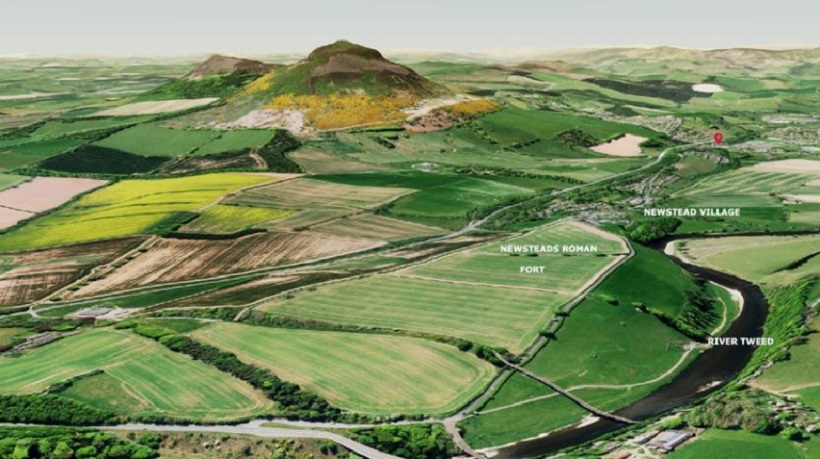
Melrose indicated in red in background
In 137AD the Trimontium fort had been reconstructed again in a much more permanent form as
part of the new Roman offensive into Caledonia. That offensive included the construction
of the Antonine Wall. The Hamians are known to have not only been to Trimontium, but they
lived there. As the pattern of losing Trimontium and then rebuilding it had proceeded
before, the manning of the Antonine Wall involved first fortifying Trimontium, then pushing
north, then falling back to Trimontium for good when the Antonine Wall was finally
abandoned. There's a museum containing finds from Trimontium in Melrose today, called the
Ormiston. Trimontium housed upwards of 5000 people, specifically including the families of
the soldiers. It makes complete sense that the Hamians would've been properly united with
their families there, and that location became their home.
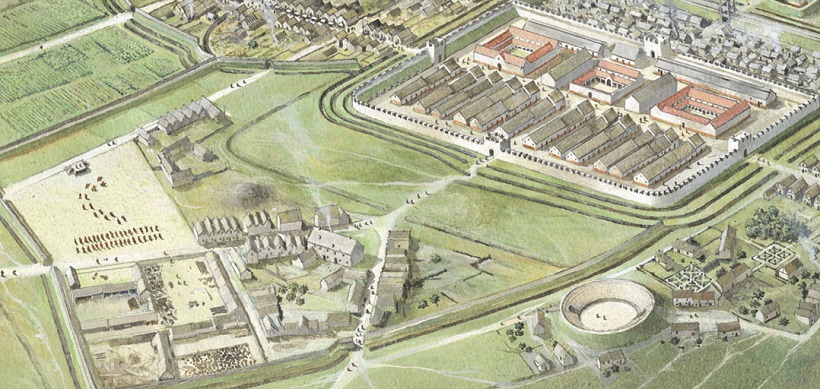
Layout of Trimontium fort and annexes
So, now lets take a step back to Magnae to put our Hamian's family into context. The
Brigantes tribe was the largest Celtic grouping in Britain when the Romans arrived. Any
women nearby to Magnae would've been of that tribe. To the east, centered in modern
Carlisle, were the Carvetii, who were probably affiliated with the Brigantes and spoke the
same language. This applies to the Selgovae to the north as well. So, the Hamians likely
started families with Brigantes women, and by 142AD they probably all had several children
upwards of teen ages. The Brigantes had given strong resistance to Roman control, which is
why the Magnae fort was built in the first place, and the situation was similar at
Trimontium with the Selgovae.
Trimontium was predominantly manned by cavalry, so the Hamians who went there were likely
mounted archers. They were summoned to the Antonine Wall in 142AD. That wouldn't have
been a place to take the family, so the women and children would've remained behind.
Trimontium at this time transitioned from serving as a fort to a manufacturing center
supplying activities at the northern Wall. It's entirely possible that a second generation
of soldiers was coming up now and went with the company. The Hamians had now served 22 of
their 25 years to transition to civilian life as a Roman citizen. Being part of the
military was prestigious. Being a Roman citizen certainly was. The people at Trimontium
were Romanized, and it's possible that they were relatively well-off. They would've been,
as long as the Romans were in Britain.
The Hamians pulled out from the Bar Hill fort and Antonine Wall in 157AD and were all the
way back at Magnae in 163AD. This is well-after the originals had completed their contracts.
Roman documents exist of prefects of the "First Cohort of Hamian Bowmen", with Roman names.
One of those could actually be ours, but it's just a few names out of hundreds of men. I
expect that the original Hamian cohort retired to Trimontium in 145AD, but they might've
continued to serve anyway. Sons of the original 500 had to be primarily serving, certainly
by 157AD, even though they were already Roman citizens, as their fathers received their
diplimas. The originals would've all been grandfathers by then, if still alive. In fact I
wonder if the 25 year service term was in the expectation that sons would take over for
their fathers as a tradition.
So, when the Antonine Wall was abandoned, Trimontium reverted to being a fort again. I
suppose with the peoples around the fort not being Romanized, ours would've stayed at
Trimontium. But the sons may have made connections with local people the same way their
fathers had at Magnae. Once settled at Newstead, I don't think the women and children
returned to Magnae, regardless if the fathers had to. Even when Trimontium was finally abandoned
by soldiers in 184AD, I'm certain that J2 boys continued to grow into men there. I firmly
believe that this is how our Scott line was established there, and it didn't venture far
from Melrose and Newstead and the Eildon Hills until they went to Derry Ireland sometime in
the 17th century. The combination of high J2 concentration in the Hamians, and knowing
they had families at Trimontium, is what gives me this confidence. The same applies to the
Elliots and Armstrongs and other border clans, particularly those with more J1 men than
others, as the Hamians brought J1 directly to Melrose as well.
Deep History of our Scott Line
In previous versions of this document, I projected a long story of all that our line must
have seen over human history. Now that I'm including here all the information I have on 15
lines connected to our Scotts, I'm going to spend less space on this section.
Whichever theory of our Scott line origin is accurate, they very likely lived around the
Eildon hills while the Romans were there. If we came from farmers, they might've been
attackers of Trimontium. A Roman presence remained north of Hadrian's Wall until 370AD,
so I expect that all Brittonic peoples changed the way they lived. The Romans completely
withdrew in 411AD, and a new change was underway. As the Roman presence faded, Romanized
Brittonic leaders had already begun to summon Germanic warriors for mercenary duties. And
it wasn't long after the Romans left that the Angles and Saxons and Jutes filled the
vacuum. It was the Angles who established settlements in the north, and over time their
influence enveloped the Eildon area. I wonder how long the Latin language held influence,
but certainly a Gaelic-related tradition was maintained until English began to rise. As
shown in the map below, by the year 700 the Eildon area was well-within Anglian dominance,
and it's likely that the language they spoke was like what's called Scots today, an
English base with Gaelic influences. Our line lived in the kingdom of Northumbria, which
means "north of the Humber" river.
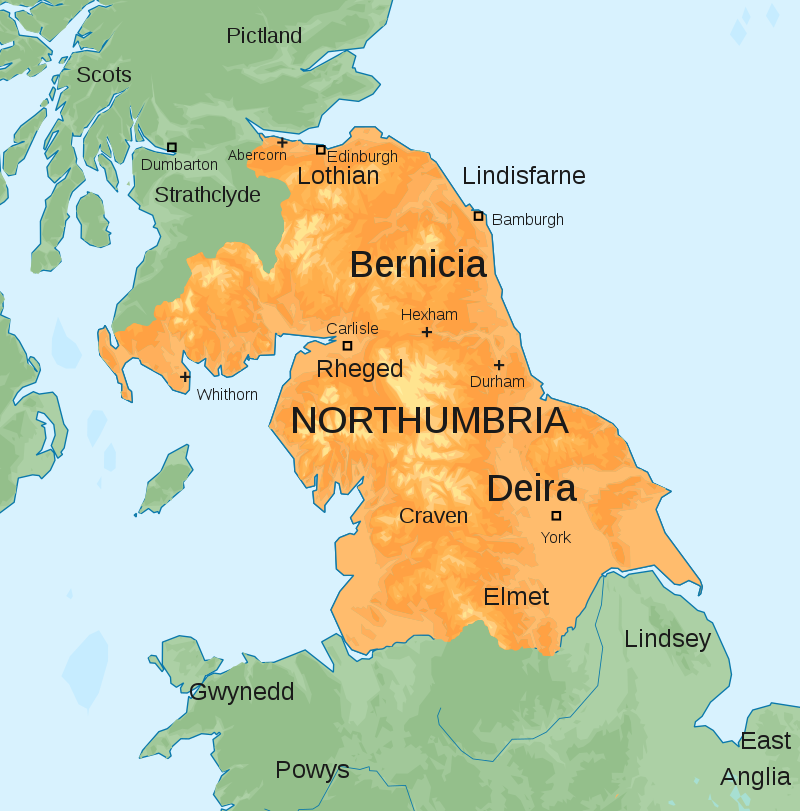
Anglian kingdom of Northumbria
Eildon was in an area that remained stably Anglian, as the Viking invaders caused
disruption from the crumbled Hadrian's Wall in the south, Irish settlers called Dal Riata
formed the kingdom of Alba in the north, the kingdom of Strathclyde arose in the west, and
then Alba and Strathclyde combined to establish Scotland. I don't know what the attitude
of folks in Eildon was at that time, but English influence receded in 1066 when the
Normans conquered, and Scott territory finally became part of Scotland. This gives perspective on the
Uchtred Filius Scot who put his name on a document in 1118. He had an English first name,
but he called himself the son of a Scot. I believe this shows that our line had no
particular desire to become Scottish, but rather as before, adapted to the paridigm they
lived in. Though our line is Scottish, border clans have a quite different history from
highland ones. It was in the late 13th century that the border reivers roamed, and
England and Scotland fought over possession of the region until unification in 1707.
So, that's a summary of what happened to our line from the Romans to their departure for
Ireland. Let's now go back to the origin of the J2 haplogroup, south of the Caucasus
between the Black and Caspian seas. By the farmer theory of migration, they would've
probably moved toward modern Syria, then went on to the west, mostly along the
Mediterranean coast, just as the first hints of civilization were forming. By my Hamian
theory, they would've followed the same early path, ending up in Hama by 100AD. So, let's
look at what happened between the Caucasus and Hama in the intervening time.
Organized settlement at the site of Hama began by 5000BC at the latest, and it's certainly
possible that our line was there. It was part of the kingdom of Ebla, which formed about
3000BC. (Ebla is a strangely similar name to Alba, is it not?) The Sumerian Empire was
just getting started, as were the Egyptians. Ebla was a peer of the greatest
civilizations, with cuneiform writing and prospering by trade. But it was conquered,
first by the Mari Akkadians by 2000BC. Hama then became part of the Amorite Kingdom of
Yamhad, speaking Semitic languages and worshipping Semitic gods. The Amorites didn't rule
Hama for long compared to other empires, and the Hittites arose and conquered Yamhad
around 1600BC. The Hittites are probably the most J2 empire in history, and it's
entirely possible that our line was Hittite in origin and came to Hama in this period.
The Hittites were an Indo-European civilization. The composite bow used by the Hamian
Archers is a technology that's believed to have come to Hama via Anatolia. If our line
was originally Hittite, they would've become Semeticised in Hama in terms of language and
religion.
The Mitanni took possession of Hama by 1500BC, and Hama had grown wealthy enough by then
to be first attested in ancient writings. Egypt then became interested in the trading
riches of the Levant and they occupied Hama, making it a part of the Upe Province of its
New Kingdom by 1450BC. But Hama was soon back within Hittite control, very close to the
border with Egypt, until just before 1200BC, when both Hittite and Egyptian power receded.
The Hittite empire completely collapsed and Egyptian power was limited to the African
continent, and the Assyrian Empire finally engulfed Hama by 1100BC. The Assyrians had
major ups and downs through the centuries, and Hama became the capitol of a state called
Hamath. It was at this time that Hamians claim their water wheels were devised, called
norias, for which the city is famed today.
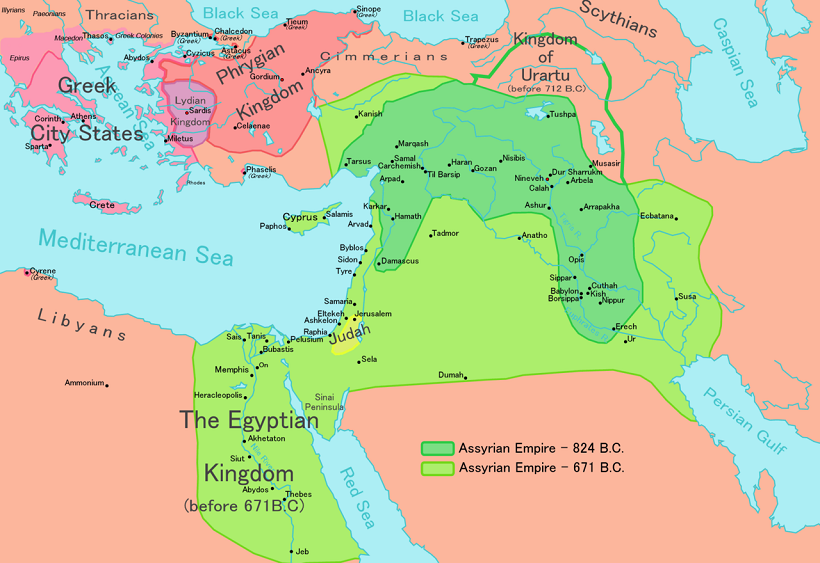
Persian power soon culminated in the Achaemenid Empire that swept through all the way to
the Aegean and Africa and the Caucasus. Our line was under Persian control then for
three centuries until Alexander the Great came a-conquering in 334BC. He died within a
few years, and around 300BC Hama became part of the Seleucid Empire, which was also
Greek. The Persian Parthian Empire later arose and reclaimed Achaemenid territory.
Syria and the Seleucid empire became one as the Parthians expanded, showing how Greek
that Hama had become. But they were now in a vise between the rising Roman Empire and
the Parthians, and a period of instability including the Roman conquest of the Armenian
Kingdom resulted in Hama being annexed to Rome with no opposition in 64BC. About two
centuries later, our Hamian was sent to Hadrian's Wall in Britannia. They were
polytheistic until they became Christian under English rule. I don't know if they still
spoke Greek though, when they came to Britain. They probably spoke Latin. The language
of Syria was Aramaic then.
How amazing is it that I can tell a story like this about one of my family lines? In
other ones, I trace even deeper in history to follow Y-DNA migration out of Africa.
Refer to those to see how the J2 haplogroup emerged in the Caucasus.
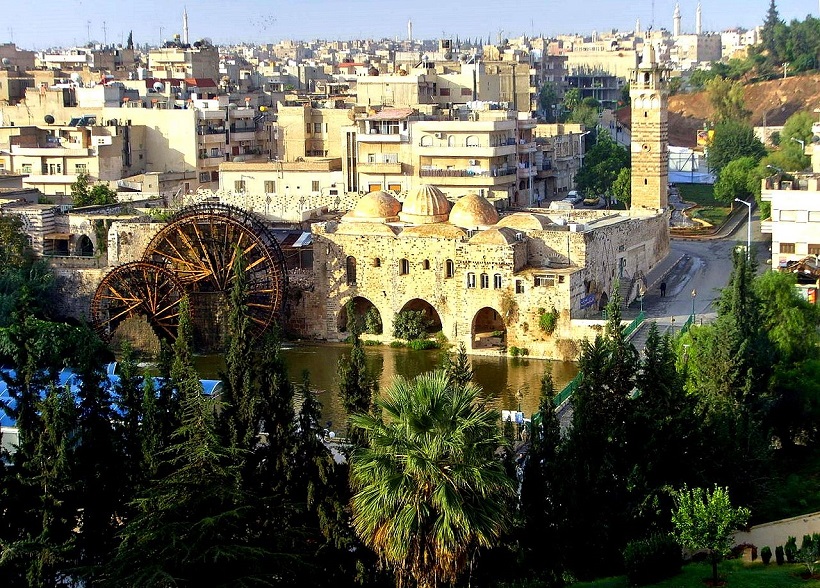
Hama Syria today
Frank Scott's other Great-Great-Grandparent Lines
In the last phase of this document, I collect all that I know about the non-Scott paternal lines of the great-great-grandparents of my great-great-grandfather, Frank Scott. Refer to the Scott Pedigree page for a simple view of Frank's ancestors.
Leonard
Frank Scott's mother was Eliza Leonard. Her father George was from Pendleton South
Carolina. By 1820 the family was in Lincoln County Tennessee, as the Scotts were, when
Eliza was ten years old. The whereabouts of the Leonards are as unclear as the Scotts
around the time of the War of 1812. I've placed Eliza's birth in Pendleton, and others
have placed her brother William's birth there in 1813. No children are attributed to
George from then until 1819, in Lincoln Tennessee. Pendleton is in the northwest part of
South Carolina, and not terribly far from Washington County Tennessee. Based on having no
children in the timeframe of the War, during George's prime years, it would seem that he
served in it. But I've found no record of it, and no enlistment like I found for Andrew
Scott. Still, I think it's quite possible that Eliza and William were actually born in
east Tennessee, maybe in Jonesborough. It's quite possible that the Scotts and Leonards
were acquainted there. It's possible that George served with Andrew and witnessed his
death. I've reported on the apparent friendship of the Scotts and Greers in Washington
and Lincoln. It seems likely that the Scotts and Leonards traveled to Lincoln together
as well.
I usually only track a family line through the woman who married into another line, to
the point of the marriage. Eliza and William Scott wed in Lincoln. I consider the later
exploits of her father as not part of my line. But before I
continue backward with George Leonard, where he ended up is of interest to me. I've
lived in the Dallas Texas area for 25 years now, and my children were born here. George
was a quite early immigrant to Dallas, when it was a very small town that nobody ever
heard about. George's youngest son, also named George, wed in Dallas in 1849. It seems
that George Sr was up for an adventure late in life and followed his child down to
Dallas from Tennessee. Remember that 1849 was four years after Texas had become a state.
As I understand it, a settlement was established in Dallas because it was the location of
a natural ford in the Trinity River, the only one for hundreds of miles. It was a stop
on the Preston Trail, a cattle driving path established in 1841, when the Native tribes
of the area were "driven off".
What is now downtown Dallas was laid out in 1844, and there were probably well-less than
a thousand people in the town when George Leonard arrived. I know of no land acquisition
record, but the Leonards laid claim to a very large plot. I read that Ross Avenue was
named after an 'early' land owner. He didn't come until 1866. I found in my research
that the Dallas Public Library has a map called the Leonard Survey that was made in 1900.
It marks off 320 acres under the name William Leonard, whom I guess was George Sr's
grandson. It seems to indicate that George Jr sold an additional 640 acres to a JW
Wright at some point. So if I read it right, the Leonards had 960 acres in Dallas! It
must've been just a prairie when they came, and even in 1900 there was no sign of
civilization. I estimate that the 320 acres occupied a large chunk between the modern
Elmwood and Wynnewood communities west of the Dallas Zoo, from Clarendon Drive to
Illinois Avenue and Waverly Drive to Tyler Street. I guess the entire area was part of
Oak Cliff when the Leonards came, because George Sr died in 1854 and was buried in Oak
Cliff cemetery, which is well to the northeast by downtown. The population of Dallas
reached 3000 in 1872.
Getting back to 1820 Lincoln County Tennessee, I should clarify that George Jr was
Sr's youngest child with his first wife. Jr was born the same year that his mother
died, 1825, so I presume that she died giving birth to him. Sr remarried the next year.
I guess that his second wife went to Dallas with him, but I haven't researched it.
George Sr was born in Pendleton South Carolina in 1789, just as the Pendleton District
was formalized, but British had begun settling the area in the 1760s. Before then it
had belonged to the Cherokee. George's father was Samuel Leonard, born in Sharpsburg
Maryland. Samuel's father was Robert, and the form of his surname was Lennard or
Lenard. Info on Robert is iffy, but I defer to sources that place his birth in
Ireland, and he wed in 1747. His wife was from England, so it seems evident that they
wed in Maryland. Our Robert died in the Revolutionary War in South Carolina in 1780,
in the Battle of Camden. I've seen claims that Robert served in the French and Indian
War previous to that, in the Battle of Quebec, but I haven't confirmed it.
Without more information, I'd have to guess that the Leonards were early settlers of what
would become Pendleton, that Robert brought Samuel (and sibings) there as children. The
family's move to Lincoln Tennessee was because of a land grant received there, from
Robert's service. I assume that the large land area owned in Texas was purchased with
wealth gained by the sale of property in Lincoln, but I have no evidence of it. The
move to Pendleton had probably been via land grant from the F&I War service. Robert truly
was a patriarch. A big question for me is if he was Catholic. The surname could come
from O'Lennard, which derives from Gaelic O'Leannain. O'Lennard could be anglicized
as Leonard. That transformation sometimes happened because Leonard is an English surname and
is similar. It's reminiscent of the case of Moore being transformed into Maurice
(Morris) in the south. The Lennard to Leonard transition seems to have happened in
South Carolina.
Given that Robert immigrated from Ireland, and that his
grandson in our line wed a Callahan, I have to assume that he was Catholic when he
arrived. If he was Catholic, he would've struggled to remain so after moving to South
Carolina. I'm sure that Catholics were persecuted there in the 18th century.
George Leonard's wife's maiden name was from Catholic Ireland, and her family was probably
in the exact same situation. Regardless, the line couldn't have remained Catholic in
Tennessee and Texas, and the Scotts in Tennessee that they married into were
Presbyterian. Note that male descendants of the Leonard line have been tested
as R-M269. Also note that the surname Lennon comes from the same Gaelic origin.
Hartsell
William Scott's mother was Caty Hartsell. She looms large in our Scott line, becoming
the leader of the family after her husband Andrew Scott was killed in the War of 1812.
At that time she had six children aged from 14 to newborn. She never remarried. My
natural assumption is this is a testament to Andrew, and to her strength. Based on my
research, she had the support of at least the Greer and Leonard families. She was
from a Lutheran German family that immigrated to Pennsylvania like the Scotts, though
I don't believe they were acquainted until about 1800 in Tennessee. Lots of Germans
followed a similar path as the Scots-Irish, so they sort of merged into the same
culture. To my knowledge, the Germans migrated more initially to the east side of the
Appalachias.
I had already determined that the Hartsells were in Washington County Tennessee because
of Caty's younger brother Jacob. I also had found Hartsells in documents there after
the War of 1812. Caty and our Scotts had left by 1816. As mentioned in the first part
of this document, I discovered the publications of Jacob's memoirs of his time as a
captain in the War. As part of the book, the author Mary McCown did some genealogical
research of the Hartsells. Some of it was new to me, and I will reference it in this
section. I had found a Hartsell Hollow previously, which is south of Johnson City
Tennessee in Buffalo Mountain Park. But McCown found better information in the
Washington County courthouse. She did her work in the late 1930s.
As we're working backward chronlogically, the first relevant piece of information from
McCown is that Caty and Jacob's mother made land transactions in Washington County,
starting in 1790. I'll get to why Hannah was doing the purchasing and selling, but for
now, what McCown found was that the Hartsells acquired land on Cherokee Creek. The
record said it was the Brushy Fork, which doesn't seem to be on modern maps. But I
soon noticed around Cherokee Creek a Hartsell Road. And a Scott Hills Road as well.
This is just to the west of the modern town of Lamar, and looks like where our
Hartsells were from 1790 until Caty wed Andrew Scott. I assumed they lived close, and
if the road names are anything to go by, I was right.
When Caty moved west, Jacob Jr remained and he died in Washington County. Jr's memoirs tell the tale
of his experience as a captain in the War of 1812. One thing I learned from him that
blew my mind, was that he witnessed a game of "town ball" in the camp on Christmas Day
1813. Town Ball was one of the forerunners of the game of baseball, where the ball was
actually thrown at baserunners. When Jacob met Andrew Jackson at Fort Strother, Jackson
told him he recognized him from Jonesborough. Mary McCown said that Jackson was a judge
in Jonesborough, but I think he was actually a lawyer. Caty and Jacob Jr were born in
Burke County North Carolina.
Caty's father Jacob was born in Bucks County Pennsylvania in 1751. I've seen his name
spelled Hartzell there, indicating how the original was being anglicized eventually
into Hartsell. Caty was his first child, and Andrew was John Scott's fifth or sixth.
Jacob being 17 years younger than John made him more likely to serve in the
Revolutionary War. I have no record of such service, but I think he did. He was in
Burke County North Carolina when the Battle of Kings Mountain happened. Caty was born
in 1780, and his next child wasn't born until 1783. Burke County sent a regiment to
Kings Mountain, and it makes sense to me that Jacob was in it, especially as his son
would be a captain in the War of 1812. The previous information from Jacob Sr's wife
Hannah comes into play now, as the fact that she made a land transaction in 1790
indicates that she was head of household, which back then meant the husband was
deceased. I've yet to research what happened to Jacob Sr, but he therefore would've
died before he was 40 years old. I doubt he was killed in the Revolutionary War, or
there would be a record of it. Hannah certainly did set a precedent for Caty,
becoming the sole rock of the Hartsells before Caty did the same for the Scotts later.
I had a death year of 1716 for Jacob Sr, which is obviously wrong. Other researchers
seem to have conflated Sr and Jr and have Sr living until 1835. This is all due to
Sr disappearing from the documentary record.
I have no record of Jacob Sr owning slaves, but Jacob Jr owned three in 1840, so I
have to presume that his father did as well. Jacob Sr's father was Hans Hertzel.
Hans was born in Reihen, a village in the Baden state of what would become part of
Germany a century and a half later. Reihen is a small village about 15 miles
southeast of Heidelberg. Hans immigrated to Pennsylvania in 1742. Ultimately the
line came from Winterthur, a city northeast of Zurich in Switzerland. They moved to
Reihen in 1651 in the aftermath of the Thirty Years War when Hans's forebear Clemens
Hirtzel, a Lutheran pastor, was summoned there by the reformed Church. A curious
piece of information from Mary McCown is a claim that the Hertzel line came from a
Reich van Hertzeele in the Cologne area. I researched this but came up with nothing.
I tend to believe there's no basis for it, especially as we know the line was only
briefly in Germany. I doubt that they had even deeper roots back in Germany again.
Male Hartsell descendants have been tested as the R-M512 YDNA haplogroup. This is
a branch of R1a, which is the eastern part of the European R-haplogroups. Typical
British Y-DNA for example, is R1b. Switzerland seems like a dividing line, where
the western part is usually R1b and the eastern part is R1a. This suggests the
Hertzels to have always been on the eastern side, where Zurich is, and they came
there from further east deeper in time.
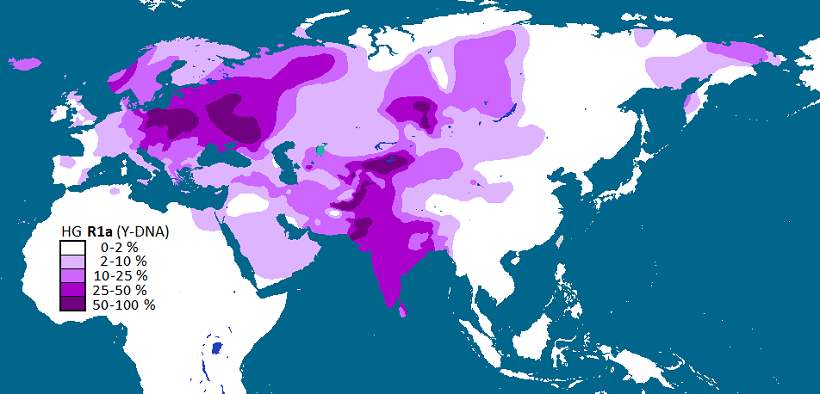
Callahan
Susannah Callahan was Eliza Leonard's mother. Susannah was born in Pendleton South
Carolina in 1792. Her father John Callahan (sometimes spelled Callaham) fought in
the Revolutionary War in South Carolina in 1781 and 1782. John's father arrived in
Maryland from Ireland in 1762, when John Jr was 6 years old. It could be that the
Callahans already knew the Lennards in Ireland, as not only did they connect in
Susannah and George, but they followed a very similar path. John Sr immigrated to
Sharpsburg Maryland and then went to South Carolina. It seems that John Sr settled
in Abbeville (his peer Robert Lennard was killed in the War), while John Jr went to
Pendleton like Samuel Leonard.
Like Lennard, Callahan is a Catholic Irish surname. I'm assuming the same for both
lines, that they were Catholic when they immigrated, then military service prompted
moves to South Carolina where it would be very difficult to remain Catholic. Our
Callahan line ends with Susannah in South Carolina, but her descendants continued on
further away from Catholicism into Tennessee and Texas. The name Callahan originates
in 10th century Munster, the southwestern part of the Isle. I don't have specifics
on where in Ireland the Callahans came from, but as they seemed to already know the
Lennards, I'm guessing that they also departed from Galway. This is just north of
Munster, and not an implausible migration. There's no clear connection to our line
in YDNA projects, but the most likely is R-M269.
Creighton
Andrew Scott's mother was Anna Creighton. Information on this line is sketchy, but
it was Scots-Irish like the Scotts, and it seems to have first immigrated to New
Jersey and the second generation went to Pennsylvania. Some of them, Anna's
brothers or cousins, set up in Adams County to the west of York County where the
Scotts were. They owned territory where the later Gettysburg battle in the Civil
War occurred. I think it's likely that a descendant was the namesake of Creighton
University in Nebraska. Anna may have first gone to Adams County before she wed
John Scott, but I'm not sure. Her first child was born when she was 18 years old,
so there wasn't much time. I don't have info on where in New Jersey the Creightons
first lived, but it was probably very close to Philadelphia.
Anna's father was Hugh Creighton. My info for him was he was born in County Down
Ireland in 1720, and he died in New Jersey. I doubt that John Scott ever went to
New Jersey, so I don't know how Anna came to Pennsylvania. Either I'm wrong, or
she traveled with kin while her father stayed behind. Or maybe Hugh came to
Pennsylvania and either returned to New Jersey or was only buried there. It wasn't
far away. Hugh's father was also named Hugh, and he was also born in Ireland. I
don't know any names before that in the line, but the name Creighton has a common
origin with the name Crichton, which comes from the town Crichton in Scotland near
Edinburgh. I've only found one lead on Creighton Y-DNA , which was a Crichton who
was R-M269. I assume the Creightons were Presbyterian at the point of immigration.
Anthony
Caty Hartsell's mother was Hannah Anthony. Hannah was born 1768 in Berks County Pennsylvania. At the same time that the Hartsells went down the Wagon Road from Bucks County to Burke County North Carolina, so too did the Anthonys from nearby Berks. In Burke County Hannah wed Jacob Hartsell. Hannah's father was Paul Antony. Paul was born in the village of Hundsbach in 1719 in what would become Germany a century and a half later. When the Antonys were there, Hundsbach was part of what was called the Palatinate. Hundsbach is about halfway between Frankfurt and Luxembourg. Paul's father was Caspar Antonie, who was from the village of Durstel in the Alsace region of France, adjacent to the German Palatinate. I don't know any details about this line, but it appears that they embraced the Protestant reformation, and migrated to Germany because of it. The Alsace/Palatinate area was unstable, having been the site of devastating wars over the preceding centuries. Like many there, the Antonies set sail for the New World in the pursuit of religious freedom. I presume they were Lutheran when they immigrated. Male descendants of Paul have been confirmed as Y-DNA haplogroup R-M269. Houseofnames.com categorizes Anthony as a surname that came to England with the Normans. It looks like our line never left France until the 18th century.
Brimer
Our Brimer line is unresolved. DNA supports the names in the line, back to the
point of immigration, but the locations are disjointed. The end point is that Betsey
Brimer wed Samuel Leonard in Pendleton South Carolina in the 1780s. There seem to be
two possible paths that our line could've taken to get there. All information I have
for Betsey's father Benjamin Brimer places his birth and marriage in North Carolina,
then he moved to Abbeville South Carolina. That would make sense, if not for
Benjamin's father Hans. It seems clear that Hans was born in the Palatinate, future
Germany. A Hans Brimer immigrated to Philadelphia on a ship called Hope from
Rotterdam in 1733. That would make perfect sense to fit in with the other German
lines in Frank Scott's tree. But a Hans Brimer lived in Orangeburg South Carolina
from 1735 until his death in 1765, and previous researchers have placed that Hans as
Benjamin's father.
In order for the Orangeburg Hans to have been Benjamin's father, Benjamin had to have
been born in Orangeburg, and then moved into North Carolina. That's just too odd to
have happened, not to mention Hans getting on a ship practically immediately after
arriving, for Charlestown South Carolina. My assumption is that researchers have
conflated two different Hans Brimers, drawn to Hans in South Carolina because the line
ended up in that state. Therefore, with Benjamin being born so soon to the immigration
point of Hans in Philadelphia, my assumption is Hans settled in Berks County like the
Antonies, and Benjamin was born there (though I doubt in the same year). Benjamin's
move to Rowan County North Carolina then makes sense. Betsey was born there in 1756.
Benjamin later moved to Abbeville South Carolina, probably in the 1770s. A move in
that direction was common.
I don't have names for Hans's ancestors, but I've seen claims that they migrated from
Switzerland to Alsace to the Palatinate. That might seem implausible, but the name is
French. I've compared the Brimers to the Antonies, and they went from
Alsace to the Palatinate before emigrating to Pennsylvania. The Harsells also moved
from Switzerland to Germany. If the Brimers were French, they may have made a
parallel move from western Switzerland to France. With these similarities, I assume the
Brimers were Lutheran when they immigrated. Male descendants of Hans are confirmed
as Y-DNA haplogroup R-M269.
Hammond
Susannah Callahan's mother was Eliza Hammond. Eliza was born in Pendleton South Carolina in 1765. Her father John Hammond was an early immigrant to the area, and operated a tobacco business. That's a bit of a euphemism for being a plantation owner. John was born about 1745 in Farnham, Richmond County Virginia. John's father was Charles Hammond, born 1716 in Farnham. Charles also came to South Carolina, and built the Hammond House in North Augusta. The Hammonds owned 49 slaves in 1790 Edgefield. Charles's father was named John Hammond, who was born 1685 in Farnham. John's father Job was probably also born in Farnham, in 1645. Job's father Martin was a merchant from London who immigrated about 1640. Geni.com traces Martin's ancestors back to 13th century Yorkshire, indicating that the family had wealth that seems to have petered out in our line by Eliza's time. It is possible though that George Leonard's very large property ownership in Dallas was a remainder of it. I have to guess that the Hammonds were Anglican when they immigrated. Male descendants of Martin have been tested as Y-DNA haplogroup R-M269.
Wilson
Sarah Wilson was the mother of John Scott, and the source of the Wilson name in our Scott line. I don't know much about Sarah. Info for her on ancestry.com is that she was born in 1714 in Pennsylvania. The only thing that's clear is she was Scottish in origin, probably Scots-Irish, probably Presbyterian. We have Wilson in other places in our trees, that could've been related. The John Thomas Wilson of the Hardcastle tree is as likely the father of Sarah as any other I've seen on ancestry.com or wikitree.com. John was born in 1678 in Ireland and went to Cumberland Pennsylvania, just to the north of York. The Hardcastle Wilson line has been tested as Y-DNA R-M269.
McMurtrey
Anna McMurtrey is the name I have for Anna Creighton's mother. The only source I have for her is ancestry.com hints, and ThruLines does support her. McMurtrey is a Scottish name, and Anna Creighton's father was Scots-Irish. Most likely her mother came via Ireland as well. The birthplace I have for the mother is New Jersey. If that's in error, she probably was born in Ulster like her husband. My research found a prospective father for Anna McMurtrey, who was Joseph born 1665 in Ayrshire Scotland. That would make the line not Scots-Irish, but I found claims of connection to Antrim. The attributed birth could've been a baptism only. Joseph seems a good fit mostly because other descendants of his were in New Jersey. Anna Creighton's mother's religion was almost assuredly Presbyterian. On familytree.com, the name is spelled McMurtry. McMurtries are almost exclusively Y-DNA R-M269.
Esther
Jacob Hartsell Sr's mother was Anna Maria Esther. Anna was born in 1720 in Bucks County Pennsylvania. The only info I have on this line is Anna's father was named Johan Jacob Ester, and he immigrated from Germany. Houseofnames.com says the surname Ester went to England with the Normans. This line thus looks like one that took the Alsace-to-Palatinate path to America, and was Lutheran. I've had no luck finding Y-DNA results for this surname, so I'm assuming it was R-M269 like the other similar lines.
Sechler
Hannah Anthony's mother was Froney Sechler. Froney, short for Sophronia, was born 1731 in Philadelphia. Her father was Andreas Sechler, born 1701 in Lomersheim, a village northwest of Stuttgart. I don't know anything else about this line, and I presume they were Lutheran. The name by this spelling doesn't have an ethnicity described by houseofnames.com. It seems that it's German, ending in -er, but it could be another Alsace line, which would be likely Lutheran and R-M269.
Pritchard
The name I have for Samuel Leonard's mother is Honor Pritchard, which is supported by ThruLines. The only information I have for this line is that she was born in Liverpool England in 1735. Her husband Robert Lennard immigrated from Ireland to Maryland in 1747, so she must've come about the same time. Surely she didn't come alone, so other Pritchards in Maryland could help to identify her father. It's also possible that her father went to Ireland and she wed Robert there before immigrating. The name Pritchard is anglicized from Welsh ap-Richard, originating in Glamorganshire. Liverpool is close to Wales, so this fits. It's also possible that Honor was Catholic when she immigrated. Pritchard is extremely likely to be Y-DNA R-M269.
Will
The name I have for Betsey Brimer's mother is Rebecca Will. Rebecca was born in 1733 and died in Pendleton South Carolina. The info on ancestry.com for her birthplace is Pendleton, which is nonsense as this was decades before white settlement began there. Rebecca's husband was of French Alsace Lutheran stock, so I presume she was too. She was in Rowan County North Carolina in 1753 when she wed. My guess is that she went through Philadelphia as I believe the Brimer line did, and she was probably born there like her husband. The name Will was anglicized from German Wull, and I've researched a Hans Adam Wull from Ottweiler- Steinbach who could've been her father. His descendants are known to have gone to Pennsylvania and North Carolina. Ottweiler is very close to Luxembourg and France, supporting an Alsace origin.
Pinson
The name I have for John Callahan Jr's mother is Nancy Pinson, which is supported by ThruLines. There certainly are unknowns in this line. A Jean Pinson from Avilly Saint Leonard, France, just north of Paris, is suggested by ancestry.com as her father, but says he never left France. I have her son being born in Ireland, which seems highly unlikely if she was born in France. Her origin is obscure, but the most logical answer is that she immigrated to Maryland with other people, probably brothers, and John Callahan Jr was born there. I won't shift the Callahan path without proof, and will just have her join them in Maryland. I presume she was Catholic upon immigration. Pinsons are extremely likely to be Y-DNA R-M269.
Coleman
The name I have for Mary Hammond's mother is Ann Coleman, which is supported by
Thrulines. Ann was born 1735 in Essex County Virginia. I don't know how Ann
connects to the Colemans of Essex, but they came there by 1690, and immigrated to
Gloucester County by 1652 from England. I don't know where in England, so I'll
guess London. Our members of this line preceded any census records, but I'm sure
they were slaveholders, especially marrying into the Hammonds. Their residence
in Gloucester was Tyndall's Point, which is just across the York River from York
Virginia. Presumably our Colemans were Anglican. Male descendants of Robert
Coleman the immigrant, whom I believe was Ann's forefather, have been tested as
Y-DNA G-M201. This is almost as interesting a haplogroup as the Scott J-M172.
It originated in about the same place, a few thousand years earlier. It follows
a similar pattern as J2, except that it had no similar affinity with ancient
civilizations, except maybe Persia. It's mostly found in modern
Kazakhstan, in a strange pattern of dense spots. Surely it came to Britain with
Neolithic farmers something like 6,000 years ago.
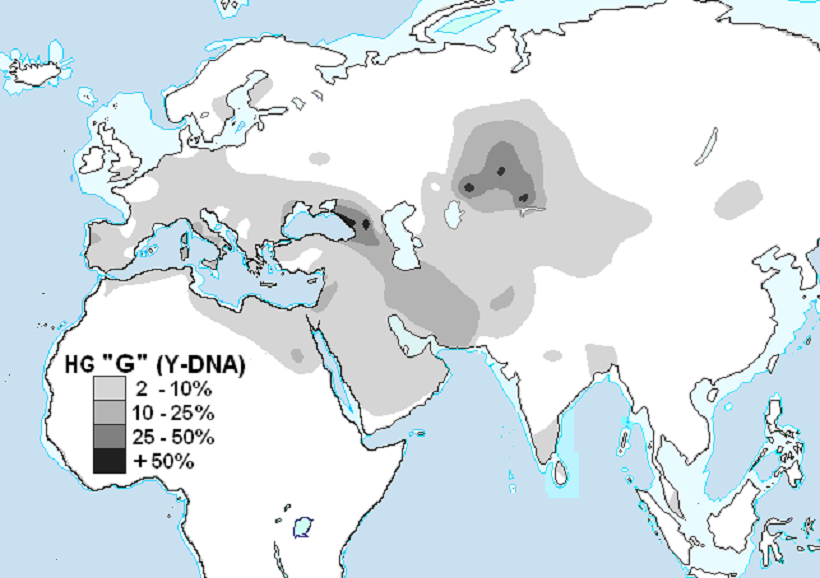
Summary of Frank Scott's Great-Great-Grandparent Lines
Three of the sixteen lines were slaveholders. This is a relatively small
percentage, but two married into each other and had a very large plantation, with
enough human property for all sixteen - multiple times over. Also note that
pre-1800 documentation is limited and more of these lines could've owned slaves.
Surprisingly, five of the sixteen were French in Origin, with one being Catholic
and the rest Lutheran. Four were Scottish, presumably all Presbyterian. Two were
German, both Lutheran; two were Irish and one Welsh, all three believed to have
been Catholic. The other two were English, presumably Anglican, and they were the
slaveholders. While Frank's tree was surprisingly diverse in terms of religion
and country of origin, they were incredibly homogenous in terms of Y-DNA, with one
J-M172, one G-M201, one R-M512, and all the rest were the typical western European
haplogroup R-M269. I don't know if the French, except for one, could really be
distinguished from the Germans, as they were very close together and most immigrated
as Germans. The only difference really was language. The Catholic lines likely
didn't remain Catholic long, which suggests that maybe they never had been. Only
the J-M172 Y-DNA came down to us, but the others do help in understanding where
Frank Scott's ancestors came from. Until I put all this together here in one
narrative, I hadn't realized just how central Pendleton South Carolina was for
Frank's ancestors. The Scotts were exceptions to the rest in most ways.
Migration paths
Scott: 1851 South Fork, Montgomery, Arkansas - 1817 Petersburg, Lincoln, Tennessee - 1816 Winchester, Franklin, Tennessee -
1795 Johnson City, Washington, Tennessee - 1772 Ebbing Spring, Botetourt, Virginia - 1730 Peach Bottom, Lancaster, Pennsylvania -
1729 Baltimore, Baltimore, Maryland - 1640 Londonderry, Derry, Ulster - 142 Melrose, Roxburghshire, Scotland
Leonard: 1810 Brushy Fork, Washington, Tennessee - 1765 Pendleton, Pendleton, South Carolina -
1747 Sharpsburg, Frederick, Maryland - 0 Galway, Galway, Ireland
Hartsell: 1795 Brushy Fork, Washington, Tennessee - 1775 Morganton, Burke, North Carolina -
1742 Bedminster, Bucks, Pennsylvania - 1651 Reihen, Rhine Neckar, Baden - 0 Winterthur, Zurich, Switzerland
Callahan: 1765 Pendleton, Pendleton, South Carolina - 1762 Sharpsburg, Frederick, Maryland -
1600 Galway, Galway, Ireland - 0 Cork, Munster, Ireland
Creighton: 1763 Peach Bottom, York, Pennsylvania - 1742 Medford, Burlington, New Jersey - 1680 Belfast, Ulster, Ireland -
0 Crichton, Midlothian, Scotland
Anthony: 1775 Morganton, Burke, North Carolina - 1741 Reading, Berks, Pennsylvania - 1710 Hundsbach, Kreuznach, Palatinate -
0 Durstel, Alsace, France
Brimer: 1785 Pendleton, Pendleton, South Carolina - 1753 Salisbury, Rowan, North Carolina - 1733 Reading, Berks, Pennsylvania -
1700 Homburg, Saarphalz, Palatinate - 0 Lorentzen, Alsace, France
Hammond: 1760 Pendleton, Pendleton, South Carolina - 1640 Farnham, Richmond, Virginia - 1600 London, London, England -
0 York, Yorkshire, England
Wilson: 1710 Newville, Cumberland, Pennsylvania - 1670 Lisburn, Antrim, Ulster - 0 Cumnock, Ayrshire, Scotland
McMurtrey: 1742 Medford, Burlington, New Jersey - 1680 Belfast, Ulster, Ireland - 0 Glasgow, Ayrshire, Scotland
Esther: 1750 Bedminster, Bucks, Pennsylvania - 1720 Hundsbach, Kreuznach, Palatinate - 0 Lorentzen, Alsace, France
Sechler: 1775 Morganton, Burke, North Carolina - 1730 Upper Hanover, Philadelphia, Pennsylvania - 1680 Lomersheim, Enzkreis, Palatinate
Pritchard: 1747 Sharpsburg, Frederick, Maryland - 1600 Liverpool, Cheshire, England - 0 Cardiff, Glamorganshire, Wales
Will: 1785 Pendleton, Pendletone, South Carolina - 1753 Salisbury, Rowan, North Carolina - 1733 Reading, Berks, Pennsylvania -
1700 Ottweiler-Steinbach, Saarland, Palatinate - 0 Lorentzen, Alsace, France
Pinson: 1765 Pendleton, Pendleton, South Carolina - 1755 Sharpsburg, Frederick, Maryland - 0 Avilly Saint Leonard, Oise, France
Coleman: 1760 Pendleton, Pendleton, South Carolina - 1690 Tappahannock, Essex, Virginia - 1650 Tyndall Point, Gloucester, Virginia -
1620 London, London, England
last edited 25 Sep 2022
